24 Foot Sailing Trimaran


Introduction: 24 Foot Sailing Trimaran

Indonesian style, built out of recycled stuff. Here we are busting out through the surf in 30mph winds at Stinson Beach California on the maiden voyage. The boat works great! There are no swimmers or surfers out because of the rough conditions. The kids are on the beach making forts out of their boogieboards instead of surfing. Specifications: Hull Length 24 ft at deck Hull 22" wide amidships at deck, 18" wide inside hull (there's a wide lip at deck) Hull 24" deep amidsnips. The hull round bottom is a semicircular arc of 8.25" radius. Hull rocker is about 4" measured from points 16' apart. Outrigger crossbeams are 14' 7" long 3.5"x2.5" fir beams tapering to 3x2.25" at ends The outrigger floats are 4.5" diameter, 19 feet long with foam plugs in ends. ~134lbs buoyant. The plugs in the front of the floats are shaped into a nose that protrudes 6.5" more. 1.5" diameter stainless steel tubing connects the crossbeams and floats. The Sail is an 8 sq. meter crabclaw / leg-o-mutton sail on 14ft. windsurfer masts. The mast is supported by three stainless steel cable stays. Total cost of materials was $200 or less. The outrigger floats are fiberglass chemical pipes full of empty plastic soda bottles. The main hull is made from a pair of old 16' catamaran hulls cutoff and glassed end-to-end. Junked catamaran hulls are easy to get. If you can't find a free hull, build a hull like the Kenya Canoe but bigger. Use scavenged plywood from crates if you want it free. The wood for the crossbeams came from a big pallet, with the nails and crossboards pulled off. Then I scarfed them together for extra length. The sail is blue tarp on windsurfer mast spars. Great action photos by kenny
Step 1: Beaching After the Maiden Voyage

Star , Damon and myself rode the boat in on the back of a big wave, just like the Malibu Outrigger manual recommends. Then we carry the boat up the beach. The sail helps us and we scamper up the beach and get clear of the break zone before the next wave hits. What a great boat. Unlike trials of previous boats in Mexico and Kenya which got badly damaged by surf landings, this boat is fine. It helps that there's a lot of wind and the boat is faster than the waves.
Step 2: Cartopping

Here it is on top of the ugly truckling. It assembles quickly without tools. The main hull is the heaviest part, about 90 lbs. It takes two people to lift it onto the roof rack because it's so big. The other parts are a lot lighter and one person can handle them. 4 or 5 people can ride in the cab of my truck. The boat could carry that many also, so it's a good match. We could only get three people to volunteer for the maiden voyage because the conditions were so rough, but there was room for more.
Step 3: Or on a Trailer

To launch it from a trailer, you drive to the boat ramp, assemble the boat while still on the trailer, then launch and land it in the usual way.
Step 4: Inspiration

I once tried to sail to Cuba in an outrigger canoe. There were some problems. When I was almost to Havana my rudder broke so I couldn't sail, the current carried me away, I was caught in a storm, etc. etc. I spent a lot of time trying to not to die and hallucinating from exhaustion. I also spent a lot of time thinking about the perfect hull shape for a sailing canoe. In the following year I traveled to Indonesia and Papua. I learned a lot by gaping at and measuring sailing canoes there. Here are some Makassarese (Sulawesi) canoes I saw in Jayapura Harbor, Papua. In severely technical terms, here's what I was looking for in a hull: 1) High prismatic coefficient (fat ends) 2) Round bottom 3) Straight sides in the middle 4) Just the right amount of rocker. Curved like a banana. 5) A beam to length ratio of around 12:1
Step 5: Cut and Paste Catamaran Hulls Together End-to-end

I found a pair of 16' catamaran hulls for sale on craigslist that were exactly what I was looking for. By no coincidence, they were designed and built by Karl Westbroek, an engineer from Malang, Java, Indonesia. They were a nice bright yellow that emphasized their banana-like shape. Hence Karl's original name for his catamaran, "Bananas". I wanted my hull to be pointy at both ends. These hulls had square transoms at the stern. So I had to cut off the sterns and butt up the pointy ends to make my hull. To figure out the right place to cut them I slid a piece of paper over the hulls to find a special transverse curve called the "Geodesic". That's the shortest path between two points on opposite sides of the hull. I cut the hulls, butted them up, and checked to make sure the keel and sides met at a reasonably fair curve.
Step 6: Thinning the Edge

Before we can start glassing, we need to grind down the existing fiberglass so it's a smooth transition. Michael Kearney helps me out by grinding the edge thin on the inside of the joint.
Step 7: Jigging It Up

Next we clamped and screwed a bunch of sticks to the outside of the hulls to hold them in alignment. Jrlee checks that the decks are parallel.
Step 8: Glassing

Jrlee mixes some epoxy. We cut and lay out strips of fiberglass cloth on a piece of plastic on the deck. We soak the cloth with epoxy. We layup the glass into the hull, squeegeeing and painting the epoxy so the cloth is fully saturated. The wider strips of cloth go over the narrow strips, so the rough edges of the cloth aren't exposed.
Step 9: Rough Fairing

I mix some glass microballoons with epoxy and slather that all over the outside of the hull. When it sets up I grind it flat with a sanding disk. While I'm doing that Danny comes and suggests a better way.
Step 10: Rapid Fairing

He's glued a board to a sanding pad and glued a full sheet of 80 grit sandpaper to that. He creates an artificial snowstorm while sanding the hull, and in a few seconds it's smooth and faired. Wow.
Step 11: Glazing and Finish Sanding

Next I squeegee some body putty over the nicks and imperfections. When that's dry I wet-sand it with a sanding block.
Step 12: High Build Sanding Primer

Next come a couple of coats of fast-dry high build sanding primer, then some wet-sanding with a sanding block, and finally a coat of yellow paint. The hull is all one hull now.
Step 13: Outrigger Floats

A friend gave me some fiberglass chemical pipes. They are 19 feet long and 4.5" in diameter. I would have been worried about the chemicals but the pipes were brand new. Actually they might be intended as covers for glass pipes. I tied strings to the necks of some 2 liter soda bottles and shoved them into the pipes. The string is to keep the bottles from floating away in case of a disaster. I carved some minicel closed cell foam to make plugs for the pipes. I shaped the front plugs into the noses seen here. The flat front feature is like the "manu" on the front of a Hawaiian canoe. As it plows into a wave, it sprays the water away forming a giant air bubble around the float. The bubble rises through the wave, pulling the float up with it. It works really well.
Step 14: Float Blocks

The outrigger floats are 4.5" diameter fiberglass chemical pipes. I made some wooden blocks to rest on them. They will be the "feet" of some short legs made of stainless steel tubing. Those in turn get connected to the crossbeams. Just like Ezekiel, the foot bone's connected to the leg bone, the leg bone's connected to the thigh bone. Here I am testing the first block I made to see if it fits the pipe right.
Step 15: Cutting Curved Grooves With a Tablesaw

I setup my ghetto tablesaw, which is a circlesaw screwed to a board. Yes, it's very dangerous. Don't do it. I set up the fence at an angle to the blade. I made a lot of cuts of increasing depth in a block of wood until I had a nice round trough cut in the bottom of the block.
Step 16: Wooden Shoes

Then I repeated the process on some narrower blocks, cut holes the right size all the way through with a hole saw.
Step 17: More Wooden Shoe Cobbling

I glued a wooden disk in the bottom of the hole so the tubing leg wouldn't touch the float directly. I heated up the block to cure the epoxy quicker. Don't breathe those buttery fumes! When the epoxy was set up I shaved the protruding plugs off with the tablesaw. I drilled some lashing holes in the sides of the blocks and cut the corners off the ends so they would enter the water better. Jumping ahead, let's go sailing and I'll show you how this stuff turned out.
Step 18: Hot Spring Break

Star organized a trip to a hotspring on the coast that's only exposed at the lowest tide of the month. We camped nearby on friday night, woke up at 5 am to hike down. It's pretty amazing. There's a main pool and also a cave full of hot water that goes back into the cliff face. We relaxed in the hot spring until the tide rose and waves of cold water started washing into the spring. Then we hiked back up to the truck and it was time to put the yellow canoe in the water. So we drove to Stinson Beach and parked as close to the beach as we could. We unloaded the canoe parts onto the grass in the park there.
Step 19: Lashing It All Together

We swarmed over the canoe, lashing all the arms and legs to it with bicycle innertubes. The front beam takes most of the load, so it has a double tube 'H' shaped stainless tubing leg that connects the beam to the float. The foot of the 'H' rests in sockets in a wooden block. The bottom of the wooden block is carved to fit the top of the float tube. The float is lashed to the block with spectra string and innertube. That part stays lashed permanently.
Step 20: Carry It to the Beach

We had plenty of help from relaxed sleep-deprived pals from the hotspring trip. When it was all tied together we picked it up and carried it to the water.
Step 21: Please Return!

In case something went wrong and we lost the paddles we wrote plaintive messages on them in hopes that someone would return them. These are instant paddles made in a few minutes from a hockeystick, a board and some string, but they're so nice it would be a shame to lose them.
Step 22: Farewell Hugs

The wind had increased to a gale. The sea was rough. Time for farewell hugs!
Step 23: Raising the Sail

We hoisted the sail and watched the waves. The surfers were all on shore so we couldn't use them to judge the size of the waves. But at least we didn't have to worry about hitting them.
Step 24: Launching!

Star , Damon, and I carried the boat to the water just as a big wave washed ashore. We jumped on, sheeted in the sail, and started paddling at the breakers.
Step 25: So Far So Good

The boat took off like a racehorse. It's easy to steer with a paddle. It goes to windward just fine. We sped toward the outer break. Wait a minute. That's a big wave coming!
Step 26: What's Going to Happen?

We hit the wave and there was whitewater everywhere. We kept going through it, and when we could see again we were still moving fast and there was hardly any water in the hull. The boat works in surf!
Step 27: Sailing and Landing

We sailed around until one of the lashing buttons broke, then decided to head back in. We surfed in on a wave, outran it, and executed a perfect landing on the back of a wave. Jubilation! The boat could have handled more passengers and rougher conditions.
Participated in the Earthjustice United States of Efficiency Contest
Recommendations

Big and Small Contest

Remake It - Autodesk Design & Make - Student Contest

Made with AI - Autodesk Design & Make - Student Contest

I TRI’D – A Self-Designed 18-foot DIY Trimaran
by Small Tri Guy | Oct 4, 2013 | Self-built Small Trimarans , Small Tri Info - All , Small Trimaran Videos | 4 comments
I TRI’D is a self-designed 18-foot DIY trimaran by sailor Mick Milne. He built this sailboat himself after researching lots of small tris and then using using “HULLS” software to produce dimensions for the panels.
The building technique is “stitch and glue” plywood — with the main hull oversheathed with two layers of fiberglass and epoxy. And the outriggers slide in on aluminum beams to allow trailering . It looks pretty good.
Mick learned all this stuff as he went along. But the best part is that he thinks it sails just fine.
Mick said the build took about 16 months in his spare time. This time frame was mainly driven by the weather, however, as the building took place outdoors in the UK, which, according to Mick, had one of wettest winters in years.
The first launch of Mick’s DIY trimaran was last October. What a day that must have been for him.
Great job Mick …. terrific! Thanks so much for sharing the story of your project (and photos) with us here. ( PS – Love the name of your boat too :-)
………………………….
I TRI’D – 18-foot DIY Trimaran by Mick Milne I have sailed for many years, mainly dinghies and small cats, though also a limited amount of coastal sailing in UK and around Denmark. I have never really lived on the coast so sailing as regularly as I would wish has always been a challenge.
Drawing plan for the I TRID Trimaran
A bit more research led me to view that a Tri fitted all the requirements I was looking for:
- Sailing reasonably flat
- Shallow draft
- Reasonable pace
- Trailerable – as long as it folds somehow
The more I looked, the more I got hooked, and I am one of those guys who once something gets under my skin I have to do it.
I spent a lot of time looking at designs and think there are some great Tri’s out there, but I like the problem solving aspect of designing something. I bought and read your book, “ More Small Trimarans, ” and noted the variety of different approaches, ranging from fully qualified and experienced designers to those who “just learnt as they went along”; that was enough inspiration for me to start my own.
First ama hull being built
The only real frustration was the weather. All the build was outside and I spend too much time removing and recovering the boat. If I build another (I suspect I will) it will definitely be under cover.
Main trimaran hull with crossbeam fittings
The small trimaran begins taking shape
First sail fitting with mainsail and jib from a Fireball Dinghy
I definitely expect to do some more modifications in the future. I am not a boat designer and there are things that are not right first time. The seating areas slide in, which I thought would help with the trailing width, but it all increases the setup time. I am going to raise them by about 1 inch , which will allow the outriggers to slide underneath without unlocking various pins etc. Also, I never really designed in an adequate system for mounting an outboard, currently fitted to the sliders it is secure but poorly positioned. I will change this when I amend the seats.
Blue deck paint on this small tri
Launch Day!
Sailing Cardiff Bay
To date, I’ve primarily sailed I TRI’D mainly around Cardiff in Wales. There were also a couple of trips into the Bristol Channel when conditions were favourable. The boat was planned for relatively calm coastal waters, with the expectation that in a few years we will move to the South Coast of England, near Poole, which has a very large natural harbour, with lots only accessible with a shallow draft, and easy access to get further along the coast.
Under sail with her tramps
Smaller trimaran moored with the big boats
Update 10-07-13: Mick sent me the following YouTube video featuring I TRI’D …
___________________________________________________________
Fantastic job Mick!
I’d love to see some more photos, or video of you sailing. I’m also fascinated by the reasons for people’s design choices. Why did you decide to design your own? Why 18 foot? Do you stand on the hull, or is there a floor? What sort of lee-board did you build? Is there a photo? What’s wrong with the outboard position? How long does it take to rig and launch?
Robin, thanks for your interest.
I have a video but am having problems uploading it, not my area of expertise but I will persevere, hopefully I will have that complete in the next couple of days, I will also provide more photos.
Why my own design – I think I covered that partially in the notes but in essence I think I just like to understand how things work and also I like doing things to see if they do work, and I suppose experience has shown me you can do most things if you try.
Why 18ft – I certainly wanted something I sat in rather than sat on, but had also read in many places the advice not to build a boat bigger than you need. Once I started designing 18ft provided enough space to seat two easily, four at a push, and provided enough displacement. I did sketch out some 16ft designs but they just seemed to be too small.
There is a floor, simply 18mm plywood , raised about 4-6 in from the hull base, this seemed to make sense rather than walking on the hull. Surprisingly there are no pictures but I will take some and post them.
The leeboard is simply plywood sheet shaped, but is already showing signs of stress. I am busy reinforcing a hardwood centreboard (with epoxy and fibreglass)which I will use to replace the plywood. I got most of the ideas for the leeboard from Frank Smoot’s excellent website which has featured several times on this blog. His explanations and points, such as that shifting a leeboard to change the CLR, really helped. There are some photos showing the leeboard which I will post.
The issue with the outboard position is the mounting bracket, not the outboard itself. As the slider mountings are round, and close together, I have had to modify the outboard bracket, the bracket obscures access to the slider locking pin and also applies enough pressure to the mounts to restrict free movement of the sliders. This means I am continually slackening or tightening the bracket , or removing it. It is just not a good piece of work. If I was designing the same boat again I would fix a wooden square bar 4-6 inches behind the slider mounts to provide easy location of a standard outboard bracket.
Rigging and launch takes around an hour though part of that is due to the launch site I use. Good launch sites are rare in UK and it is a busy site. I have to rig the mast, the jib , outboard, and seats at a trailer area, and then having reversed onto the ramp extend the outriggers and tighten the tramps, then launch. I then normally rig the main on the water. Part of the work to modify seats, outboard mount and a few other small tweaks is to reduce this time, though I do think rigging the boat is part of the experience so I would not want to have no rigging to undertake.
I hope all that that helps answer your queries and I will put together some more photographs showing some of the detail, and hopefully that video.
Love it, Mick. I’m always excited when any bold venture sets out to, not only build, but design their own trimaran. I’m on maybe my 10th “home brew” tri now, and each one has been not only a blast to build and sail, but a real education as well. My latest (a 19-footer) is probably my best so far. Set-up time was always an issue for me, too, which is why I ended up with a folding design and an unstayed mast with the 128 sf sail furled around it. My designs are shaped by the places I sail (shallow) and by the fact that I always beach launch. 18′ is probably the perfect length for a tri you can launch, rig, and sail alone. Your boat looks great, and I’m delighted that my leeboard info was helpful. Couple of questions, if I may: What does she weigh in at, all up? How much sail are you carrying? Have you had a chance to speed test with a GPS yet? All my boats have hit 14 mph (white knuckling it, for sure!), but I haven’t hit 15 yet. I think I will, though, with my new vertical batten sail. I’d be happy to email you some photos, if you like. Also, I now use solid lumber for my rudder and leeboards, covered in 4 oz glass. They last much better that way (I got tired of having to constantly repair them). Again, excellent job! And I liked the video as well – mainly because you kept the camera moving and we got to see most all of the boat. Cheers, “Trimaran” Frank
Hello Mick,
Congratulations for your boat ! I’m very interested in your 18 ft trimaran because i have the same project. I have some questions : Is there any drift ? where it is ? The seats are fixed under the tubes, that ‘s it ? is it a self draining background in the cockpit or not ? Did you purchase specific sails or you pick up them from an other boat, witch one ? what is the the mainsail area ? what is the weight of your boat ? You designed your boat with what software ?
Thank you for your reply Best regards x.lemaire
Submit a Comment
Your email address will not be published. Required fields are marked *
Notify me of followup comments via e-mail. You can also subscribe without commenting.
Blog Post Categories
- Production/Commercial Small Trimarans (291)
- Self-built Small Trimarans (678)
- Small Trimaran Audios (30)
- Small Trimaran Videos (289)
- Trimaran Design, Rigging, Construction Info/Links (222)
- Contact “Small Tri Guy”

Wayne Barrett has been building boats for 50 years, many of them world renowned. His latest venture is a DIY trimaran kit that embodies his half-century of expertise and celebrates “the joy of building and sailing your own creation”.
21 April 2020
Advertisement
Famed in multihull circles and the creator of high profile vessels such as Trilogy and Indian Chief designed by Tony Grainger, and Traveller, the 50-foot tri designed by Dick Newick, Wayne Barrett describes himself as “a little guy designing boats on the kitchen table in an apartment on the Gold Coast, with a nice view over the lake.”
He has built some “100 or so boats” over the years and his passion and prowess have inspired him to create the M80 trimaran, an 8-metre vessel designed with the home builder in mind; those with limited time or space, and some basic experience with hand tools.
The versatile M80 can be specified for cruising or racing and the larger 9-metre design will have a range enough to sail across the Atlantic.
“In 2021, I’m planning to sail the 8-metre boat up to The Whitsundays as a promotional exercise to showcase the vessel. It’s very manageable for single-handed sailing.”
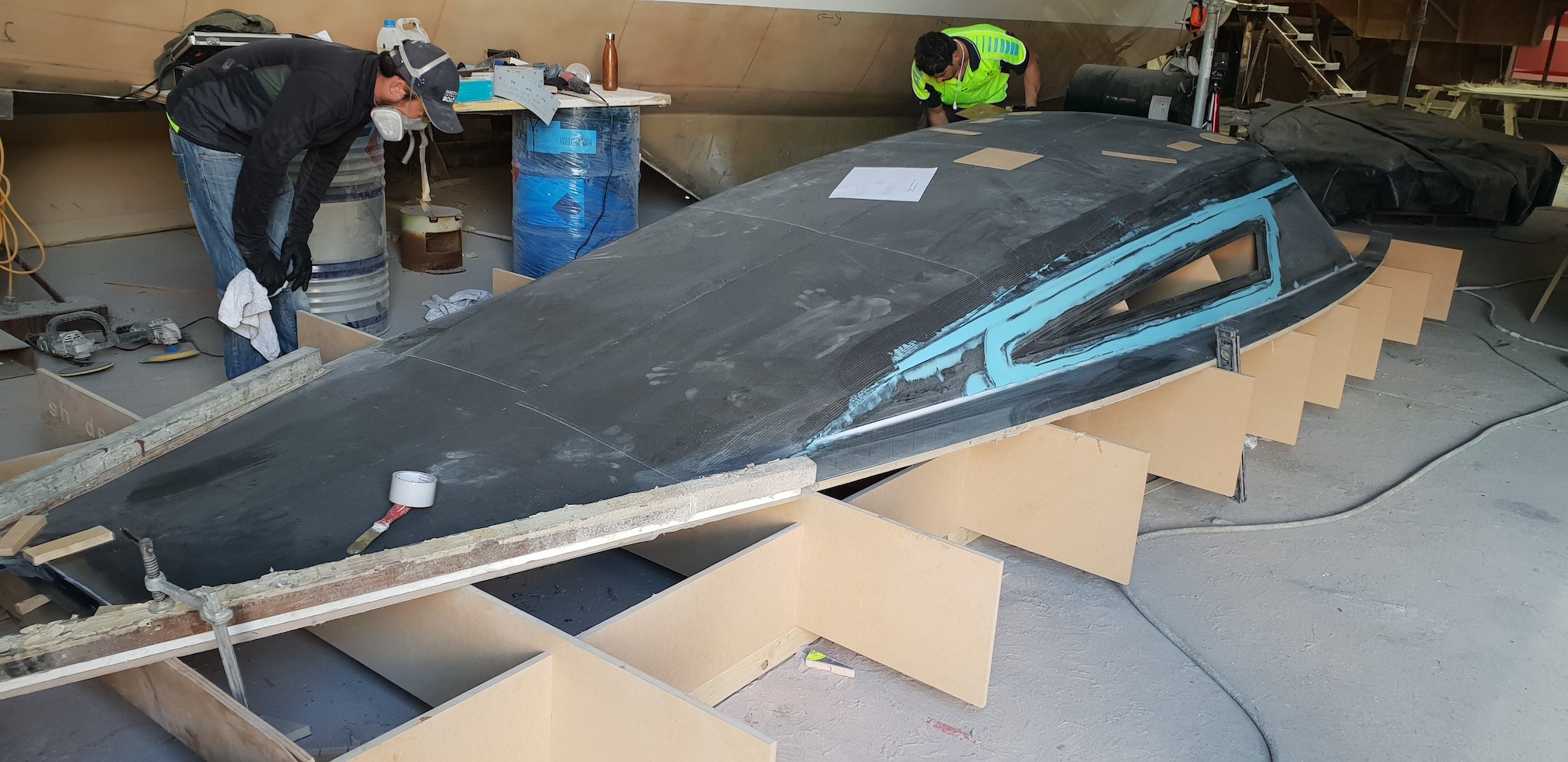
The concept arose from Barrett’s belief that sailing should be within everybody’s reach.
“I’ve built quite a few complicated, high-performance multihulls over the years and I’m aware they consume time that’s way beyond what an amateur could devote to a build.
I used the flat panel concept, adapted to tri design and put it out there for amateur or professional builders.
“A friend of mine I’ve been sailing with for 40 years needed a new modern Buccaneer 24, a plywood 24-foot Crowther around in 1966. I’ve built a few of them, and a B33, B40 and a Spindrift 37. I thought about it for a year or so, then did something about it.
The spiritual successor to the Crowther Buccaneer 24, Mojo, was originally designed with a central cockpit, a double bunk down aft and a galley and head forward, which I thought was a great concept. But I scrapped that idea and went with a conventional aft cockpit.”
The first boat, in Brazil, set sail just over three years ago and since then, Barrett has sold plans around the world.
“A mate of mine from Geelong, Andrew Johnson, is building one at Lightwave Yachts at Coomera on the Gold Coast with the guidance of Roger Overell. It’s well into the final stages and will be used for cruising. It’s made totally from carbon, so it’s light and strong.
“There’s another one being built in France, a 6-metre design being built in Melbourne and a 9-metre design close to completion in The Netherlands. I’ve sold 9-metre plans to Germany and one in Sydney, revised to be all flat panel, foam and round bilge, with aesthetics to suit that owner.”
The main attributes of the design that have such broad appeal are its simplicity and economical package.
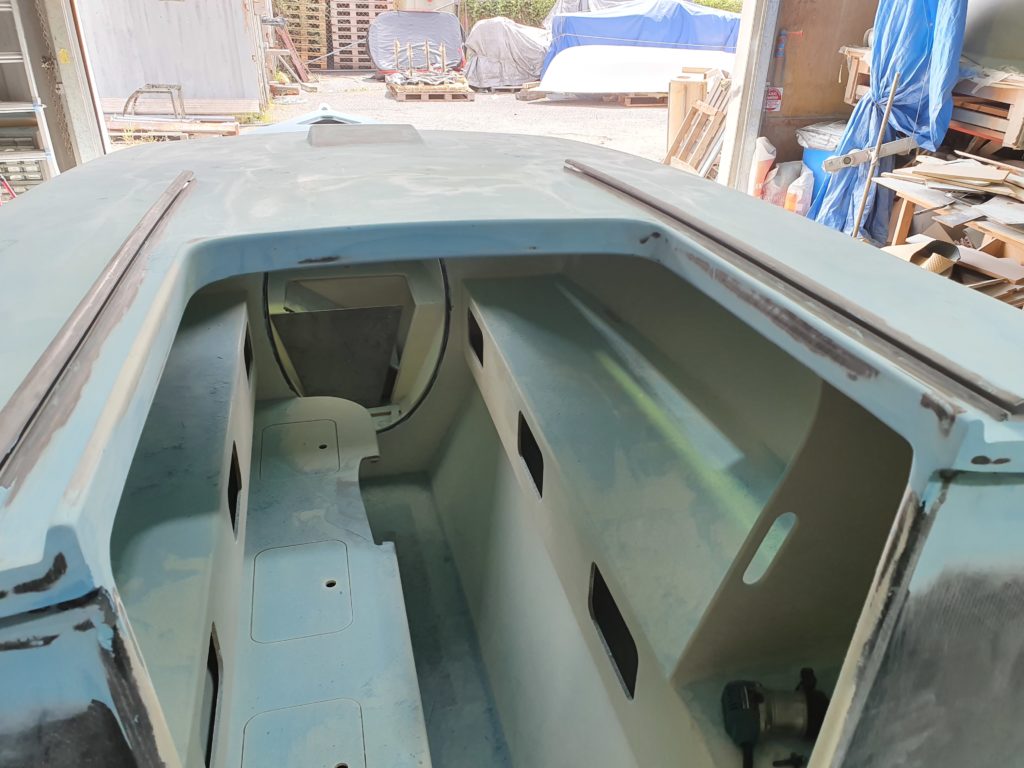
“Initially the concept was built around plywood, which has been a common material for 100 years and most people are familiar with it,” explained Barrett. “The benefit of ply is that a guy can build it in his own shed, over time. But other than the 9-metre in The Netherlands, people are all keen on the foam and epoxy.
“Foam and epoxy is a bit more costly, but comparing the total price is attractive for an amateur builder. It can be built from CNC cut panels in a fraction of the time compared to some other options, alternatively you can build it from our easy to follow plan set for DuraKore, DuFlex or foam core kits.”
Barrett has worked with ATL Composites for the past 25 years on numerous projects, including the 9.2-metre Trilogy, which held the Aust Championship title for around 10 years, Traveller and the 13-metre Gary Lidgard-designed cat Saloon Bar .
“I also built a 7.5-metre caravan which appeared on the ABC program, ‘New Inventors’ five or so years ago,” continued Barrett. “I used ATL Composites ’ products, including foam and resins.
“ATL spent a lot of time scanning the surface of the moulds so we could get an accurate pattern for the shapes of the foam core. I built five of them, all custom designed and built, all traveling the country. It was a fantastic looking thing!
“ATL has always been fantastic to me, in their general support, timely supply of goods, always bending over backwards to help.”
Getting started is straightforward, according to Barrett.
“People buy the M80 plans, complete with DXF files and they can have all the flat components cut out with CNC or jigsaw by hand”.
“If you have plenty of time, it’s cheap. An average handyman or woman, with basic experience with hand tools could put it together in their garage or workshop. In The Netherlands it’s being assembled under a tent to keep rain and snow out. Where there’s a will, there’s a way to boat the world over.”
trimarankit.com
atlcomposites.com
Your next adventure
Caribbean nostalgia
Don't miss out!
Subscribe to our newsletter for yachting news, reviews and events.

Lunada Design
Creative Boats for Home Builders
Category archives: plywood trimarans, back bay sit on top kayak, a modular system approach to sot kayak sailing, paddling and mirage drive propulsion.
Sit-On-Top (SOT) kayaks are easy boats on which to learn to paddle. They have none of the “get in the coffin and you are about to drown” psychological identity that one finds in the Sit-Inside boats and they’re amazingly adaptable to a wide range of paddling activities. It also doesn’t hurt that they are pretty straightforward boats to rotomold, which makes them very cheap to produce in large numbers.
I didn’t envision just one boat for this niche in the home-built kayak market. Instead, it came to me that there would need to be at least three models that could address the wide-ranging styles of boating interests in this area of the kayak world. The result was a couple of very clean, SOT models at 14’ and 16’ called the Corona and the Back Bay, respectively. The third model was going to be called the Wahoo, as it was specifically designed for the folks who spend a lot of time fishing with their SOT’s. I’ll get to the Wahoo in the next article.
As a canoe and kayak sailor and a guy who had just been out for a test drive on the Hobie Adventure Island, which is based on their 16’ SOT Adventure model, I wanted to offer my own take on what makes for a truly fun and stylish, sailing SOT kayak. The result was that a fully integrated system of component parts was designed for the basic Back Bay. This modular approach allows the Back Bay to go sailing by simply adding a system of light-weight, easily built elements that quickly convert the SOT to a single aka sailing boat called the Scorpion, OR, to a double aka sailing boat with slightly larger ama volume, called the Doubloon. Of the two configurations, the Doubloon is most like the well-known and highly respected, Hobie Adventure Island.
The Corona and the Back Bay are virtually identical models, save for their respective lengths. For the purposes of this article, I’ll focus on the Back Bay version and all the potential add-on systems I’ve incorporated in the design.
THE BACK BAY SOT KAYAK
Specifications: Length overall – 16′ Beam overall main hull – 28″ Depth of hull max – 12” Weight – 48 lbs. or less Displacement – 335 lbs.
This boat is built in the S&G style of construction in 4mm marine ply with 6 oz. plain weave fiberglass set in epoxy on the inside and outside of the hull for full laminate sandwich strength. The build process uses external cradles as building supports, ensuring that the hull goes together with minimum hassle when handling the rather slender and longish hull panels. The boat is bulkheaded internally at three key points. These bulkheads create not only integrated strength in the design, but they also cleanly separate the hull cavity into four unique volumes for gear storage and watertight flotation.
The Back Bay can be configured with a large, open tankwell set aft of the cockpit, or built with a watertight, aft hatch cover for internal storage in a conventional kayak style.
Specifications: Beam overall – 10′ Weight (est.) – 90 lbs. Sail Area – 56 sq. ft. Displacement – 350 lbs. Draft (board down) – 28″
The Scorpion variant is a Sit-On-Top design for fun sailing, paddling, or Mirage peddling… or all three, as the builder desires. There will be a design for a leeboard mount included in the plans for those who are going to build the boat for sailing. Having the aka gull wing form set well forward permits a full paddle swing arc. The aka beam connectives to the amas is split into a pair of mounting elements. I did this to make for a stronger, single beam mounting struture. With a single beam design, there is a tendency for the am to want to rotate around the beam, making for a very stressed component that could lead to early failure. By splitting the beam and spreading the mounting points, I have given the structure more resistance to this rotational force, making for a more rigid boat in use. This setup will allow the owner to power sail in light air with both the paddle and the sail providing thrust. With the leeboard swung down for sailing, the owner can do some “power sailing” and utilize the Mirage drive, as well as the sail, in light conditions. The Mirage is capable of boosting boat speed enough that it creates apparent wind over the sail, adding power where there really isn’t enough for sailing alone.
The amas are positioned to optimize capsize resistance when sailing off the wind. The amas do not touch the surface of the water at rest in stable trim and provide only minimal wetted surface drag when underway by paddle or peddle. As soon as the sail is loaded by the breeze, though, the ama on the lee side begins to immerse, firming-up the boat and resisting the heeling moments being generated.
The aft deck can be configured as a watertight hatch with full access to the aft sections of the hull, OR a large, diving tank well with self-draining ports. The cockpit is fitted with self-drain ports under the seat as well as forward, in addition to the daggerboard slot. There is a watertight deck plate just forward of the seat, between the knees of the sailor/paddler to provide secure storage for critical items that may be needed on a routine basis. The foredeck has a watertight hatch cover for bow storage needs.
The rig is a fully battened Dacron sail with two reef points and a multi-section, self-supporting mast which steps into a sealed mast socket in the hull. The mast and boom sections can be aluminum or carbon, as budget permits. The sail choice is open for the customer as long as it can be balanced with the fixed positions for the mast and dagger board. The Cunningham is run to the deck of the gull wing aka to keep the rig on the boat in the event of a capsize.
With 56-sq. ft. of sail on a 90-pound boat, this will be a decently speedy boat without being in over its head all the time in a stiff breeze. I suggest two reef points in the sail to allow for sailing in a wide variety of conditions.
This will be a wet boat at speed, yet there are no worries at all for flooding and sinking, save for a truly nasty trip over a reef that shreds the entire underside of the craft. The bow, cockpit and aft hull volumes are all independent, sealed compartments, as are the ama volumes.
Reentry from a swimming session will be easy with a simple, sling, or rope ladder much like those used by rock climbers, called etriers.
The boat is constructed in a multichine, marine plywood style with epoxy glass laminates inside and out in a stitch and glue style. Stainless T-Nuts are embedded in the hull deck surface from below to provide a secure set of mounting points for the aka wing. The amas are held in place on the aka tips by large bungees and a notched lock system. This system provides for quick setups on the beach.
You just fit the aka to the foredeck, insert four, 1/4″ threaded stainless screws with comfortable, knobbed grips and screw down the aka wing. The amas slip onto the ends of the aka and you lift the pair of 3/8″ bungees up and over two raised hooks on the aka ends to secure the ama in place. Simple, easily maintained and near foolproof in operation.
DOUBLOON SAILING SOT
The Doubloon is the second variation on the central SOT theme of this group of boats. In this design, I am looking to provide a more expansive utility application for the base, Back Bay SOT version. The Doubloon is essentially a solo craft and it carries the same, 56 sq. ft. sail, but the overall potential of the boat is expanded through the use of dual akas and full trampolines on both sides of the Back Bay hull. The rendering of the Doubloon shows a daggerboard inserted down through the Mirage Drive trunk, but in use, I would prefer to have the board mounted outside the Back Bay hull as a leeboard. Plans will be supplied with the leeboard solution.
The akas on the Doubloon are spaced to allow for a full paddle stroke with the boat setup as a trimaran. There are two sections of tubing that span the opening fore and aft between the akas from which the tramp is mounted. The trampolines are designed to roll-up on the outer tube section, much like a window shade and they are deployed by an endless loop of light halyard line. With the tramps fully deployed, the inner tube section lifts up and over a holding pin in the aka and the sailor applies as much tension to the tramp as he feels he needs by hauling-in the endless loop line and cleating it off. If a paddling session is desired, he simply pops the jam cleat and pulls the line to roll-up the tramp on the outer tube section. This procedure applies for both port and starboard tramps.
Like the Scorpion, the Doubloon can be built to utilize a Mirage drive in the center well and the need to roll-up the tramps for paddling is essentially negated, (though it is nice to have the option once in awhile as Mirage drives can be difficult to maneuver in tight places)
The aka beams are held to the deck of the Back Bay hull with the same, threaded knob strategy for quick setup and takedown times. Similarly, the amas are held to the aka ends with hefty bungee cords for the simplicity of use. There’s another, rather invisible, benefit to using the bungee cords for ama mounting. Because they are being held in place through a fairly dynamic hold-down system, the amas can move about, ever so slightly, while underway. This allows the amas to have some structural “give” and the result is that the banging and thrashing that is typically experienced by the ama, is somewhat dissipated through the flex of the joining system.
All in all, I think the Back Bay SOT should be a really fun boat to own for warm water/warm weather boating adventures. It has the capacity to carry enough gear for several days out on the water. When rigged with a sailing system of your choice, it can also cover some pretty good distances if the winds are favorable. Plans for this boat and all its variations will be available from this site and Duckworks Magazine.
Chris Ostlind
Lunada Design Chris@Wedgesail.com
Solo 12 and 14, corsica 15r, sports car performance on the water.
Over the past couple of years, I have taken a break from my boat design work. During that time, I’ve been able to reassess my connection to the craft. The last boat I designed was the Europa 20, which is a trimaran meant for vertical strip foam construction with sandwich style, infused epoxy/glass laminates inside and out. The Europa is a boat for very fast day sailing with a very light hull and a very big rig. A boat that is not for everyone, to be sure, as it requires a level of skill that the average guy does not typically cultivate in the course of experiencing their recreational boating interests.
In stepping away from the larger, more powerful beach type multihulls, I came around to the desire to produce a smaller, very quick and sensitive boat that would appeal to recreational sailors and not just those guys who want to blast around with their hair on fire (though I do suspect that in the right hands, this boat will do just that). The new design had to be easy to build with standard, marine plywood/epoxy/glass techniques that did not rely on exotic layups with spendy carbon cloth. (Well, maybe the carbon will sneak in there a bit on the beams for the guys who want to play with a bigger rig)
Looking long and hard at the smaller skiff-like hull designs I had done before, such as the Montage, I decided to draw the new boat in that same general size, but with a very different approach when it comes to how the boat achieves its performance potential. Where the Montage has a relatively spacious cockpit capable of taking on a couple of adults, (or a parent and a couple of smaller kids) the new, Corsica 15R trimaran would be for one adult (or accomplished kid) designed solely for a unique, one-up sailing experience within the small beach multihull genre.
As a result, the boat has minimized clutter when it comes to excessive high-tech trickery. With that approach, the Corsica 15R is also going to be a boat that has much lower maintenance requirements in order to keep it in top sailing condition, as well as a much lower realized cost to get it on the water and ready to sail.
If you are into cars, as I am, then think in terms of a nicely pumped, Mazda Miata, type of boat that would be a cool, weekend canyon racer for one person. A boat that could blast around the local waters in a good breeze and give chase to other small, fast, multihulls being sailed by crews of two.
The result of this conceptualizing process is the Corsica 15R. The C15R is a boat of modest, marine plywood build techniques and is very light weight for its generous sail area. With this boat, the normal sailing position would be the skipper, semi-reclined within the main hull, driving his machine like an F1 Grand Prix car. In this configuration, the boat is designed to utilize foot pedals for steering, leaving the hands free to work the sheets. But, that’s not the only way to sail this boat. Owners who wish to sail in a more conventional multihull style, can sit-up out of the cockpit and onto the main hull cockpit gunnel, or even the trampoline surfaces all the way out to the ama, where they will steer with a tiller extension.
A construction style in multichine, 4 mm marine plywood, allows the boat to be assembled in a well-understood fashion that will go together quickly. With a subtle placement of minimal stringers and sufficient bulkheads, the C15R becomes a strong main hull shell that can absorb the loads from its sizeable rig, turning the power of the sails into forward thrust in the water.
There is no fully enclosed transom on the vaka hull. The cockpit deck is slanted gently down and aft for automatic self-draining, such as is seen in sport dinghies and larger race boats. A collection of bulkheads under the cockpit deck provide structural support and watertight compartments ensuring that the boat will not likely sink even if large sections of the bottom are torn out from an underwater hazard while smoking along in a gin clear lagoon.
The demounted boat can be assembled easily by one person. The gently gull-winged akas are built with a glassed box beam core. The inboard ends of the akas slide into tapered sockets in the main hull and are levered in place with stainless waterstays to make ready for sailing. This, tapered socket technique prevents binding while assembling the boat, while providing a solid, hassle-free and weight minimized demounting system. The leading edges of the akas are smoothly shaped foam blocks that are glassed onto the box beam to provide an aero component, as well as creating reduced drag from waves and spray. The akas are hard fastened to the amas as a complete assembly that is easily removable from the vaka hull. The trampolines stay mounted to the akas and amas for transport and only have to be hooked and tensioned to the main hull during assembly.
The mast is a stick from a Hobie 16. I specify the addition of a set of spreaders from the Hobie 18 mast to stiffen up the H16 mast to handle the additional righting moment generated by the Corsica design. Naturally, I’d prefer to see fresh sails in something like fully battened, Pentex laminate, but builders on a tight budget could also work with a loft service to tweak a reasonably fresh Hobie 16 main and jib and do just fine. The addition of reefing points on the main are strongly suggested, as well as the use of furlers for the jib and spinnaker/screacher. For those who desire fresh sails for this boat, I would recommend the folks at Whirlwind sails in San Diego, California. http://www.whirlwindsails.com/
A removable carbon prodder sets the tone at the front end of the boat. The stick originates as a carbon windsurf mast, so it is easily found on the used market and equally replaceable, should it get poked into an unyielding environment. For trailering, the sprit unpins, slides out of its socket and is stowed in the cockpit for transport and storage.
Corsica 15R Specifcations
LOA 14’ 11” (4.54 m)
BOA 13’ (3.96 m)
Displacement 650 lbs. (294.8 kg.)
Sail Area (upwind) 218 sq. ft. (16.17 sq. m)
Spin 142 sq. ft. (13.19 sq. m)
Mast Length 26’ (7.62 m)
Draft (board up) 1’ (.3 m)
Draft (board down) 42” (1.07 m)
The mast is raised by the traditional beach cat method of physically lifting the mast with the base pinned to the mast step, or by utilizing the long daggerboard in its trunk as a form of a gin pole. A forward hoisting line is led over a pair of sheaves at the top of the daggerboard and down to the hand cranked winch on the trailer. Mechanical leverage quickly raises the mast so that the forestay can be fastened to the bow, stepping the mast securely. You can see a few photos of the process at Brent’s L7 trimaran site:
http://home.comcast.net/~ritakend/site/?/page/Mast_Raising/&PHPSESSID=864f3404e3f46ed29dd99b863018fc1d This is a very simple way to raise a mast should you need to avoid the trad lifting exercise for one reason or another.
I chose to not go with tricked-out, curved lifting foils in the amas due to construction complexity and added cost for the builder. Foils of this type are hard to build correctly by hand, as are the needed curved trunks in which they slide. Instead, the boat is equipped with a daggerboard that is inserted through the deck of the main hull in front of the mast which angles aft to exit the hull below the waterline. A daggerboard and trunk of this type are much simpler forms to build and orient in the hull. It is also just one main foil, where lifting foils need to be made in pairs, one for each ama. Lifting foils also need complex control mechanisms to retract and deploy the foils and they have to work from the cockpit remotely with the foils mounted way out in the amas. The needed controls are an interesting problem when the boat is 13’ in width and the driver is semi-reclined in the main hull.
Note: I’m not against an owner who might want to experiment with foiling for this boat, even if it is just foil assist and not full flying. It would require a lifting t-foil style rudder and twin Bruce style foils in the amas, or, if a person is really accomplished as a composites builder, they could make a pair of matching c-foils for the ama. The owner just needs to know what level of additional work is involved and at what skill level they need to perform in order to get the desired result.
If you are on a budget, the rudder and headstock from a Hobie 16 will work just fine for the Corsica with some mods to the tiller. The more deluxe, Rudder 25 system from Dotan will also work well, should you have the coin. http://www.dotan.com/ If you plan on pushing the boat hard, then a longer blade will be required, or you can get yourself invested in the process of putting a rudder on each ama and have stunning control at your finger tips. On the down side, that change will cost you a bit out of your pocket and at the launch ramp in setup time… though I can see a nifty rig with light alu tubing and the use of snap buttons as a cool solution.
The Corsica 15R will be a light boat built from familiar materials. It should be a fairly simple building experience for the owner and will fit comfortably into any typical garage space, making it easy to find a building location. It will quickly assemble for sailing and be hassle free with minimal maintenance required to keep it in top form. It can be towed behind any compact car on a typical beach cat trailer and when demounted for travel, is road legal anywhere in the world. On the water, this boat should be quite quick and behave with predictable, pin-point sailing manners. With the skipper slung comfortably in his reclined cockpit seat, he will be decently protected from the effects of the weather and sea state while tearing around his local waters.
NAGARE 21′ AND 17′ MIRAGE DRIVE SPEEDSTERS
Making use of mirage drive propulsion with more efficient hulls designs.
Nagare (nah-ga-ray) is a Japanese word meaning Flow.
Both of them are configured as trimarans with fairly small and unobtrusive amas designed to give the boats remarkable stability in a wide range of conditions while allowing the vaka, (main) hull to be decidely slender for more effective drive through the water.
The Nagare sisters also have incredibly narrow waterline beam numbers that, when coupled with their fairly long hulls provide for very easily driven hull forms for high efficiency per unit of energy applied.
I expect both boats to operate at the very high end of commercially available paddled boats of the same length, beam and weight. So, yes, they can go pretty quickly, but that’s not the real purpose.
The real benefit of the design genre is through the ease with which they are propelled at any given speed, compared to other boats of their size. This efficiency translates directly to those using the boats as less tiring for miles covered, or greater speed with the same effort as other, wider designs.
Because the propulsion is derived from the largest muscles in your body, the leg muscles, rather than the arms and shoulders, there will be less fatigue for each mile traveled. Because leg muscles are so much bigger than arms, they will be able to do more work in a given period of time, making for longer possible trips, as well as the mentioned lower fatigue issue. With a less fatiguing effort, more people will be able to enjoy the experience of being out on the water for daylong adventures.
NAGARE 21 DOUBLE SPEED AND STABILITY FOR DOUBLE RECREATIONAL BOATERS
The Nagare 21 uses a set of amas, mounted on a pair of simple, anodized aluminum tubes with quick release snap buttons holding the sections together for easy disassembly for car-topping. If a trailer is used to transport the boat, the beam of the Nagare 21 falls well below trailer maximums, so nothing special needs to be done to take the boat to and from the water. Two Nagare 21’s can be trailered, or car-topped, by removing one of the amas and placing the main hulls close to one another on the racks, or trailer. The removed amas easily fit inside the hulls and they are ready to go. The whole affair on the rooftop is very much like a pair of sea kayak doubles. Because of the length, I would not mount a boat this big on any compact cars. You would be very likely to rip the rack right off the roof in strong side winds.
Steering is by means of a simple, flip-up style kayak rudder with control lines run through the hull to a convenient steering lever in the cockpit. I suggest the SeaLine SmartTrak rudder system (do a search for supplier), the P-41 Multi-purpose rudder from Onno Paddles http://www.onnopaddles.com/onnocomponents.html and the Feathercraft rudder system for hardshell boats. http://www.feathercraft.com/accessories/rudders-hardshell.php These are really great rudder units and will give excellent steering control with minimum drag.
NAGARE 21 SOT OPTION
This boat can be built with a full cockpit tub so that it functions as a Sit-On-Top kayak with full drainage through the Mirage drive openings. Auxiliary drain ports are located in the tub for rapid removal of any water that comes in over the side of the hull. I suggest the SOT option for warm water users, with the more traditional kayak style, Sit-Inside hull form for those who will be using the boat in colder water, or more frequent inclement weather.
The SOT version has internal bulkheads for support of the SOT tub, along with the capability of adding a small circular deck plate for an additional watertight compartment in the cockpit that is perfect for small items, such as cameras, wallets, car keys, etc.
The SOT variation is an optional element to the base plans. If you wish to built it as an SOT, drop me an email at my regular email address and I’ll get back to you.
ROUGH WATER USE
This is not really a boat that is meant to go out in rougher conditions, such as those where a full-blown sea kayak might be right at home. It’s meant for quieter waters, such as lakes, bays, harbors and bigger rivers. It can take a session in 1 or 2 foot breaking surf, but I would not expose the boat to bigger waves, especially in a shore break scenario. You may find yourself out from the shore a bit when the wind comes up, producing steep, choppy waves. The basic Nagare 21 will handle this easily because only the cockpit will be exposed to swamping. The amas will keep the boat stable while you pedal to shore, or a quieter place on the water, where you can bail-out the boat and continue.
It is a perfect boat for sightseeing, bird watching, fishing, photography, and just simple, energy efficient cruising with near bomb-proof stability (you can stand up in the boat while out on the water without your partner coming completely unglued, for instance).
The Nagare 21 is a fast, comfortable and unique boat for a couple who like to get out on the water, but do not want to hassle with the business of capsize that is present in other types of boats, such as kayaks and even canoes.
NAGARE 17 SINGLE A NEW STYLE OF SOLO BOAT FOR TROLLING FISHERMEN
The solo version of the Nagare series has some very different twists, compared to its bigger sister. It has the same, highly efficient and easily driven, slender hull technology, the same set of trimaran style amas well aft for big time stability, the same generous cockpit opening and the same convenient utility for car-topping or lightweight trailering.
The design elements that set this particular boat apart from its sister craft is that the Nagare 17 has a very special capability when it comes to fishing.
AFT FACING TROLLING
Anybody who builds the Nagare 17 and intends to use it for fishing will probably be knocked-out by the potential for facing aft while trolling. Imagine using your legs to quietly drive the boat forward while you casually set trolling rigs, eat a sandwich and keep an eye on the fish finder… all while keeping an eye on the rigs you have set, with them easily at hand?
This is the signature utility development with the Nagare 17, designed specifically, for fishermen. It works like this…
The fisherman loads his boat, drops into the forward facing seat, hits the iPod for his favorite tunes and jams out across the lake at a remarkable speed for a human powered boat. He zips across the lake in virtual silence because he’s driving a very skinny and efficient hull with no engine sounds. Once he arrives, he’s going to make a few sneaky trolling passes with his Mirage drive pushing him along over that monster crew of Pike that are hanging around on their favorite piece of structure. Wham! Fish On! and the day starts with smile on his face.
If you’ve ever fished from a typical Sit-On-Top, you know that you have to face forward while trying to look over your shoulder while trolling. Hook-up and then you have to swivel around, grab the rod and go after the fish. All the time you are doing this, you have to balance the boat carefully, because the whole tamale could go over and end your day right then and there.
Well, that’s how you used to do it, anyway.
With the Nagare 17, you can take it to a whole new level of fishing pleasure. The Nagare 17 is equipped with twin Mirage drive trunks. When driving the boat forward and facing forward, the Mirage drive is dropped into the forward trunk and a tractor-style seat is dropped into the aft trunk with the seat bottom resting on the top of the trunk.
To convert the boat to aft facing trolling and fishing, you simply stand up in the boat and swap the Mirage drive for the aft mounted seat plug and the seat then goes to the front trunk… facing aft. With the Mirage drive still set to drive the boat forward, you simply sit down and start pedaling, slowly, up to your desired trolling speed.
Now, you can watch your fish finder, GPS and your trolling rigs while you continue to tool along at your favorite speed for nabbing the fish. Get one on and simply work that rod while continuing to face aft. No twisting around in your seat, no ”just about dumped it” scenarios, just simple, fun fishing in a very stable boat. What could be cooler than that?
With the fore/aft balance point of the boat set right between the two drive trunks, there is but a very minimal change to boat pitch when you change the direction you face.
The Nagare 17 is further designed to accept an insulated and watertight tank between the two aka tubes where they run through the aft deck. You can use this for all kinds of stuff like: your catch, fresh bait storage, cold beverages if you catch and release… whatever suits your needs. There is plenty of room between the two drive trunks for a pretty good sized tackle box and lots of room up forward of the trunks for any of that “other stuff” that fishermen seem to sneak aboard their boats.
A moveable electronics unit can be fastened at the forward end of the cockpit, or unhooked and moved around aft if you’d rather have it facing that way.
Maybe you want to cast lures or flies instead of troll. The boat is so stable with the two, wide set amas, that you can stand up and cast all day without ever feeling like you are getting the least bit tippy. All in all, the Nagare 17 is quite a boat for fishing, as well as just plain fun, recreational pursuits.
The Nagare sisters represent a unique design family for human powered vessels. They are quick, stable and with their unique styling, represent a distinct departure from the looks of traditional boats one typically sees on any given shore or launch ramp. Both boats are designed to be built in marine ply Stitch and Glue methods for the hull sections, with cedar stripped decks to take advantage of the really beautiful, smooth curves capable from that style of building. You can paint the lower sections of the hull and leave the cedar decks natural with a deep varnished finshed, for a real knock-out boat that will really gather a crowd.If you really want to have a plywood deck build instead of the cedar strip build, write and twist my arm gently. I can design that change for those who really like to build that way
Plans are not yet complete, so if you would like to build one of these two boats, please send me an email and I’ll put your name on the mailing list for information, or watch the plans section of Duckworks for the notice.
CHRIS OSTLIND LUNADA DESIGN CHRIS@WEDGESAIL.COM
Another Trimaran/Skiff … Bigger, With More Power
Well, you had to know this would happen…
When the Montage Skiff/Trimaran was introduced, the Lunada Design website was absolutely flooded with an ocean of page hits every day right after the article was posted. I received several dozen personal query letters regarding the boat and sizeable slice of them were directed at the potential of a bigger version of the Montage.
The concept of being able to build your own boat and rig it with a used mast and possibly even used sails, (if they are in good enough condition) had struck a chord with the homebuilding community. The creation of a larger version of the Montage would take the specified rig choices up into the much more commonly found beach cat rig sizes and make the business of finding a used rig in great shape, a whole lot easier. After pencilling a collection of thoughts and running some rough numbers on the potential, the idea came into focus as the 18′ Collage.
The ama shapes, especially on the smooth hulled variation, borrow other design cues from the modern performance dedicated French designs of VPLP, as well as the very cool work of Nigel Irens. The transoms are nudged in the direction of a triangular shape, while retaining some of the typical beach cat, flat-topped U-form feeling. The volume concentration is well-forward, with the foredecks being much more rounded to provide rapid shedding of water. These shapes will help to reduce the tendency of multihulls to pitchpole when sailed hard.
Breaking away to some degree, from the single, build style of the Montage offering, the Collage is presented as a fully strip built, smooth hulled version, as well as a multichine plywood version. These choices will give builders the ability to work with the material choices and aesthetics they prefer. I am also looking at the potential for a foam cored sandwich laminate boat using the vertical strip technique, though that iteration will probably come around a little later in the process.
Collage Specs
LOA 18′ ( 5.48 m ) BOA 14′ ( 4.26 m ) BOA main hull 41″ ( 1.04 m )
Sail Area Main 163 sq. ft. (15.14 sq, m.) Jib 55 sq. ft. ( 5.12 sq. m. ) Spinnaker 161.5 sq. ft. ( 15 sq. m. )
Displacement 1000 lbs. ( 454.5 kg. ) Weight 380 lbs. ( 172.7 kg. )
The Collage meets all the same design criteria as does the Montage, except it’s longer and wider, has more sail area, carries more crew weight and yes, it’s going to be faster in the right hands. Faster… sometimes this term can be kinda self-defeating when speed claims are made compared to another boat. When it comes to recreational boats, I’m of the opinion that speed is a relative thing based on the overall design brief of the boat in question. In the case of the Montage and Collage designs, speed is one of the attractive elements as long as it is kept in perspective with just what the use application will be from day to day. From where I sit, this will be primarily recreational purposes.
The Sail Area to Displacement ratio ( SA/D ) for each of the boats is as follows: The Montage is 31.56 and the Collage is 34.88 With both of these boats being sailed at near max displacement, I give the nod to the Collage, based on waterline length, as well as the ability to punch through wave conditions that will toss the Montage around to some degree.
I would like to see this pair of boats ( Montage and Collage ) blasting around in the hands of skilled sailors. There’s nothing quite like the feel of a performance boat and the way it can deliver the exhilaration of a spirited ride. But… I’d also like to see this boat out on the water being used by families while they have a really fun day on the water with, maybe, a somewhat toned-down speed blast tossed into the mix every now and then to get the kids chirping.
I’m looking at the potential for the Collage to create a new beach and/or lake sailing culture in which energetic hot shoe dudes, as well as young sporting families, can all mingle on the beach, out on the water and share a communal BBQ after the day of sailing. I grew to maturity on the beaches of SoCal watching the brand new Hobie Fleets do this very thing and it was a lifestyle that perfectly fit my beach kid way of thinking. It would be great to see that happen once again. Could this take place in 2009? Hey, I don’t know the answer to that one, but it is fun to think of the boat and its owners in those terms.
There’s a lot going for the Montage/Collage design approach to support such a social event concept. Both boats are affordable to build, they are easily trailered by even sub-compact cars, they make use of “experienced” parts that can be had on the open market for pennies on the dollar when compared to new parts and they are boats that are easily sailed on the first day. This last part is important, as the boat will attract more enthusiasts when they see that they can be sailed with what pretty much passes for beginner’s skills. Just because it can go fast, does not mean it has to be sailed that way. As the owner’s skills grow, the boat’s potential will be there waiting for him.
As a way of introducing the Montage and the Collage designs to the homebuilder market, I’d like to offer free plans to one person. This builder should be able to show me that they have a very strong interest in either design and are willing to build the boat as I supply the plans in accordance with their progress from the previous plan set delivery.
If interested in this offer, you can write me at: Chris@Wedgesail.com or at lunadadesign@gmail.com and make your pitch. The one chosen to receive the free plans will be willing to provide construction photos of their progress and a brief written description as to how things are going. The personal accounts will be published on this website, Lunadadesign.net so that the readers of the site can follow the projects.
Chris Ostlind Lunada Design
This boat created immediate appeal to beginning and intermediate sailors. It offers much of the speed experience of a high performance skiff in a stable and predictable platform that is really tough to capsize. The Weta is one of the first boats to encourage family participation and reintroduces the waterborne fun of the beach sailing culture, established way back in the late 60’s with the intro of the Hobie catamaran.
A brand new, factory built Weta goes out the door for USD $11K. Realistically speaking, this isn’t an in surmountable amount of money for a factory produced, brand new carbon trimaran. It is, however, quite a lot of money for most casual recreational enthusiasts and the folks who like to build their own boats… especially when you consider the rugged economic conditions we all face these days.
The estimated $5600 figure represents a boat with a whole host of brand new parts. For the clever builders out there, the Montage could be even less expensive if they can find a used 470 rig, perhaps a used small craft, or beach cat trailer that could be modified to fit the hull design and even a collection of hardware in good condition. The Montage is a very light boat at right around 235 lbs., so you do not need to buy a heavy duty trailer.
I went back to the drawing table and reconfigured everything so that the longest hull panel was going to just fit on a couple of sheets of marine ply laid end to end. The main hull also got just a bit wider in the process of lengthening the boat. Where the factory boat uses carbon fiber on foam cores for its structure, the Montage will be a 4mm marine plywood design with full fiberglass/epoxy sandwich laminates inside and out. The foredeck and the cockpit seating transitions are strip-built in Red Cedar to give the overall appearance of the boat a smoother, more organic feel than straight plywood panels.
The amas for Montage came from a 16′ trimaran design that I had already done and required minimal re-design to work with this boat. The amas are also designed as multichine ply forms with pretty high volume shapes well forward and a water shedding deck form that will helps to keep them riding high even when driven hard. Ama displacement is 100% of the all-up boat weight when sailing.
Montage Specifications
LOA 15′ 6″ BOA 12′ BOA main hull 41″
Main 110 sq. ft. Jib 38 sq. ft. Screacher 102 sq. ft.
Displacement 650 lbs. Weight 235 lbs.
The aka beams are anodized aluminum instead of carbon tubing. The inboard ends fit into fairly burly sockets in the hull and are held in place with quick release pins. Flat deck flanges on the ama ends are welded in place and bolted to the amas. The amas are removable from the aka tubes for repair or maintenance, but otherwise stay mounted, along with the trampolines, as complete units.
The mast is also anodized aluminum. The boat uses the same mast section as the 470 dinghy, which is a Proctor Cumulus section. This mast is available on the used market with a little bit of hunting around. If you want it all and have the money, then there’s a very cool, filament wound Forte carbon spar available with very close specs to the Proctor that will rock your world. http://fortecarbon.com/
Making these two changes from the benchmark, all-carbon Weta to an aluminum spar and tubing keep the costs down, with but a slight weight penalty over all-carbon parts. If you find a used mast, the savings will be even more substantial.
I have found that the more expensive sailcloth laminates are capable of driving the boat just a bit faster, but for the average recreational sailor, they will hardly ever make a difference compared to more forgiving sails in Dacron. Dacron is much easier to maintain, lasts longer, is a lot more tolerant of UV exposure and can be repaired by any sail loft wherever you go. If the builder of the Montage really wanted to, they could buy a set of sails in something like Pentex laminate instead and they’d have that hot, performance boat look that some desire along with just a bit more zip under sail.
The aluminum aka tubes will be sold pre-bent and ready to install on the amas. If the builder has access to a good mandrel bending facility that can handle the OD/ID specifications of the tubing, they can fabricate their own tubes to supplied specs.
The Montage is designed to be a really fun day sailing machine that can generate near performance skiff sailing speeds while offering a hugely stable platform for recreational sailing. Construction of the boat is very straightforward in marine plywood with glass/epoxy laminates and can be easily built by any sailing enthusiast who has household handyman skills with tools. The Montage has been created to offer homebuilders an opportunity to enjoy this style of family sport boat at a completed cost that is far less expensive than the manufactured version.
CHRIS OSTLIND
Fresh take on the solo16 s, a safe, speedy solo cruising craft for adventurous souls.
After a lot of input from readers of this site, I have completed the modifications to the Solo16 S design that reflect many of their expressed interests.
The Solo16 S now has a bit more displacement as a direct response to suggestions for the use of a small 2 hp outboard and some spare fuel. At the same time, the vaka hull was given additional beam above the waterline and the shear was raised some to allow for mods to the amas.
The amas, themselves, were made slimmer and taller, while retaining the same volume. They now have a slight vee section which gives the boat a progressive resistance increase as the amas are pressed heavily in a gust.
To complete the changes, a sporty all-weather soft cabin has been designed to allow the owner a chance to sail in a wide spectrum of conditions. The new cabin is modular in its approach with the ability to address a multitude of sailing situations.
All panels except the Bimini have generous window areas which are backed by micro mesh screen that is small enough to keep out the No-See-Ums. The PVC windows are zip-out removable and the screens can be rolled-up for maximum airflow through the cockpit. The complete enclosure system allows the owner to mix and match the panels as needed for the best protection from the elements.
When setting up the boat for sailing while on the trailer, the owner simply lifts the ama assembly, rotates and places the ends of the aka tubes into the matching vaka openings and slides the ama into place. The akas are fully seated when their internal, spring loaded snap-buttons click into place. The entire ama assembly is easily handled by one adult with modest physical strength.
In the trailering mode, the complete boat does not exceed 68″ (1.7 m) in width, falling well under every trailer width limit in the world.
Fram's Building and Sailing Pages
Introduction.
Hello and thank you for showing interest in the building story of Fram, my F-39 trimaran.
Using the “Next” button at the bottom of this page will guide you trough the whole construction process. But be warned, there is a lot of information and thousands of pictures, so it can take some time for the interested reader.
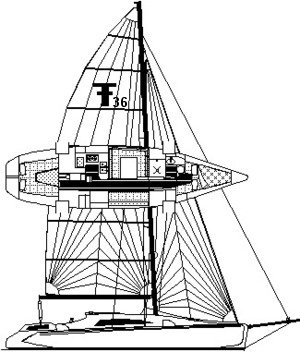
Initially, the choice for my new to build boat fell on the high-tech F-36 trimaran, a design by the famous New Zealander Ian Farrier ( † RIP Dec.8, 2017).
In those days the F-39 did not exist yet. Although the F-36 missed my preferred folding option, the design nevertheless meets most of my wishes. According to Farrier, there was simply not enough demand for a folding option for such a large trimaran. And is it not true that a boat is always a compromise ?
Actually, the determining factor to go on with this Farrier (F-boat) design was the superbly detailed building plans and the building method. The more I studied the plans, the more I realized that this boat is an engineering marvel and accompanied by an building method that I could manage. So all necessary attributes for an high quality yacht!
However, somewhere in my head I still felt the obligation to find out whether it was not better to outsource the construction to a suitable yard. Though, I had already realized that this would be far above my budget, which was indeed proven by offers from various yacht builders at home and abroad.
“The desire to build a boat ... begins as a little cloud on a serene horizon. It ends by covering the whole sky so that you can think of nothing else.“ quote Arthur Ransome
I can not deny that this state of mind led to the purchase of the building plans. A stack of paper from which a boat has to be built. This is the beginning of an almost incalculable adventure.
I bought the original F-36 plans in the spring of 2000 and planned the start of the construction process by the end of that year. But it worked out differently.
And I want some new furnishings too ................
And the kids want a bigger rabbit hutch..............
By finishing this and carry out your promises I will be ready for the project.
Of course she was right !
Update to the F-39
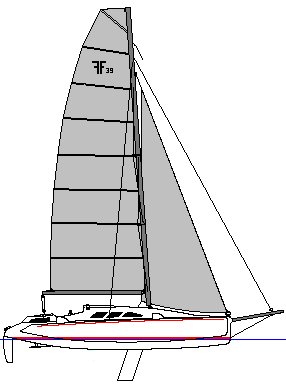
Autumn 2001 everything was done. In the meantime I have been searching for materials and suppliers, and have negotiated for prices and specifications. As still being a greenhorn in composites, I tried to get familiar with all these composite materials and worked on another F-36 (thanks Gary Mulder) to go through the laminating process of the main hull.
And just before I ordered the materials for the first float there was a very welcome note from Ian Farrier that he decided to upgrade the F-36 to an F-39. The new design is not only larger but also includes a number of improvements, the latest design insights, rotating mast and last but not least the folding option.
So this delay wasn't too bad at all and now I could update without any trouble and not having done the wrong things. Spring 2002 I ordered the updated plans. Not all drawings were ready yet but there was enough to make a start.
In the spring of 2003 the form frames for the first float are upright.
Vacuum Resin Infusion.
In the year 2000 when I started to study the possibilities for a DIY boat building project, I was a total composite greenhorn, but I already had learned that a vacuum treatment was desirable to get the lightweight multihull quality I was looking for. However, it was hard to find any information about how to get a vacuum densified laminate within my range of possibilities.
I learned to understand the vacuum bagging technique but the implementation looks to be very challenging. At least to me. The fact that this technique should start with old-fashioned hand lay-up and then to be completed within the time constraints of the resin clock currently looks very discouraging to me. And for laminating and subsequent vacuum bagging the hulls are many helpers needed for which I do not have enough space in my humble workshop.
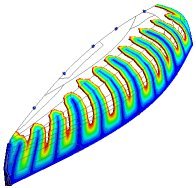
An article in our local ″ Zeilen ″ magazine put me on the trail of the vacuum infusion technique. This has given me a whole new perspective on the matter. Although, there was almost no information available, except that it was some kind of black magic, operated behind closed doors by some very professional boat building plants.
A breakthrough was made possible through the purchase of knowledge at Polyworx in the person of Mr. Arjen Korevaar.
With almost no previous composite experience, I suddenly saw the possibilities to make my boat building project possible and still be assured of the best possible quality. After all, vacuum infusion is a defined process that not depends of my initially lack on knowledge and experience and skills for laminating big boat hulls. It gave a boost to the preparations.
Earlier in the eighties I have built an epoxy/wooden boat, somewhere in a remote barn. From that I learned that I will never build a boat again in a different location than at home.
In the past I did a rebuilding of the garage of our modest house with the intention to enlarge the living room with the aft part of the (former) garage. But I had also a hidden motive to built a new boat, so the actual joining with the living room had still to wait some time ....
Building at home is essential for me. Despite the small room for this project, it is much more efficient than a workshop somewhere else. It's save, I can leave the things behind me and every single moment of the day, or when I feel like to do something, the project is just a few steps away. But the most important advantage is the fact I can stay at home and near my family, a great benefit to family- and social live.
With extension the working area is about 13 x 3,7 m², but the height is not enough to join the two main hull halves together. So I have to do this somewhere else.
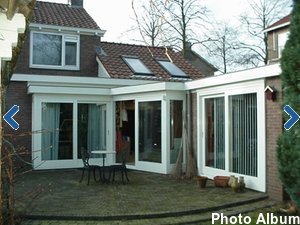
Since there is only just enough room for the main hull (or halves), I made an attic floor for workbench and vacuum table. In fact, the whole floor is a 3,5 x 3,7 m² bench and a standing room is 0,9m. lower in front of this (removable). With the main hull in place, I don't need this lower floor anymore as working at the bench is possible while standing on the F-39 cabin roof.
However, I still need to learn to have the discipline to be very organized and clear, to be able to manage this job in this limited space. Anyway, I don't have a choice. I would never attempt such a project in another location than at home.
As I am going to build with epoxy, there is no inconvenience with bad smell because epoxy is almost odorless. Which is not the case with the two part painting products. These have an awful smell and for this reason I installed a big ventilation unit capable to maintain a low pressure in the workshop. With this the painting fumes flow outside instead of causing troubles with the family.
Workshop extension
There was still one difficulty to overcome: the garage is 2m. too short so I had to enlarge the garage a bit. This turned out to be a big problem in our highly civilized and urbanized small country! July 2001 the plans for a temporary extension were sent to the officials of the my hometown.
By the end of August they decided to turn my request down...............
As I've said before, home building is essential. No permit is no project, but this is something the Jacks-in-office didn't want to know and certainly would never understand. (and here they are right, it's nuts probably ;-)
Wow, I never expected this. The extension is simply, small and temporal while I knew (almost) for sure the Dutch building laws must allow this! So next step was to raise an objection to this decision and for this we have a special committee of independent wise men. They decided that the refusal was taken on wrong arguments and advised the officials to think about other arguments for a refusal (no sailors neither)!
Now it became a bad joke. Better arguments were hard to find, but they found them, legal ones against a temporary extension, but, as I found out, nothing against a permanent extension...........
All parties were agreed that this enlargement is not an embellishment for the house, so the legal permanent option is the worst solution. This strange situation came to an climax by a special permission by the Lord Mayor himself, which allowed me to build the temporary (and inexpensive) option. I received this long awaited document in the summer of 2002.
After one year of struggle, the actual building of the workshop extension was finished in just 3 weekends. Even the neighbors like the result and are getting curious about my activities (which are quite abstract for non-yachties).
I started the building of the F-39 in the Spring of 2003 at home. By the end of 2009 I have build and finished both floats as well as the starboard half of the main hull together with some interior parts as settee and galley. Roughly a little less than half of the entire construction job, although it has taken much too long.
But then that once-in-a-lifetime opportunity came along ....
2010 Changes, another workshop
While sitting in the sunny garden in summer 2009 and looking at the successful work we did with once more an alteration of the house (expanding the attic into a fully-fledged living floor), we thought we had made a good descision to cross out the idea of once moving to our ″Dreamhouse″ and instead making our house more comfortable. That dream was living near the water with the boat along the garden jetty. This kind of villa's are always far above our budget.
However, it is a buyers market nowadays and while having peace with the decision to give up this apparently not realistic dream, a once in a lifetime opportunity came along. A radical turnover lead to buying a house with a private harbor on the South side of the IJsselmeer, without any bridges or locks to pass and with plenty of room (33'x40') for the unfolded F-39, very rare in our little country.
When I had known this just a few months earlier, we would not have start the extension of the roof. Now it is not finished yet and we are moving to another house. Challenging times so to speak !
So, the Fram project had to move to a new workshop, which I found quite nearby and not coincidentally being our company workshop.
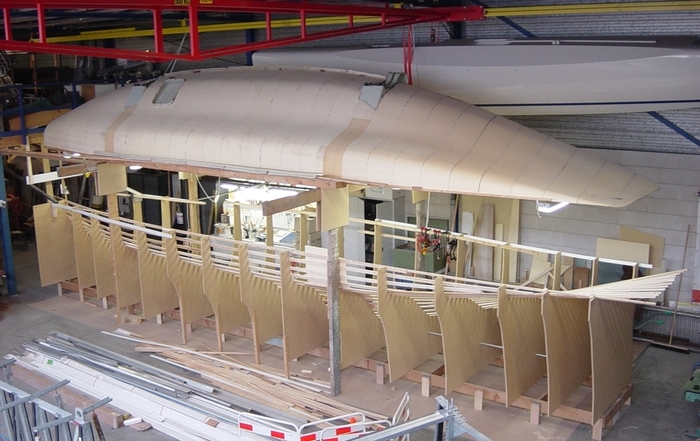
Much more room, but also not at home, which was a major condition to undertake this huge building project. Much less privacy too. This of course is a temporal solution with the necessity of getting in a hurry. This means from now on I will focus on finishing the F-39 on the outside and get her in the water to tie her up along the jetty of our new home. Further work on interior, hardware and rigging will be delayed till she is at home again.
What is my schedule ? This seems to be the most important question, not anymore for me but apparently for others who have asked me that already 1000 times. My answer has always been simple, next year! And that is the most accurate answer I can give as that planning turns out to be correct every year.
It is a part-time project, besides a day-job that requires a lot of time and attention, and I work in spurts and bursts, not steadily. And always on my own without any outsourcing. One needs an optimistic mindset because everything takes three times longer than previously thought. I now know why many of these kinds of projects are stranded halfway.
I once met a German catamaran builder and asked him how many years it has taken him to finish his beautifull catamaran .... 14 Years ! was his answer. I complimented him with the great result and shake hands, meanwhile thinking ″that man must be bloody crazy, not my piece of cake ...″
There are only a few F-39's sailing in the world nowadays. Almost all have been built commercially. A sign on the wall? I know of some half build project, resting in parts in a remote barn somewhere, waiting for that enthusiastic builder who will take up the challenge again. But I also know of some almost completed projects that are not far from launching.
It's time for more F-39's in the water.
My schedule:

Please be warned! If anything on this web site appears to be a recommendation on how to build a boat it is an error of writing or editing. This site is my builder's documentation to chronicle the adventure I had in building Fram.
The Internet is such a lovely open source. Remember this when you see something in this website what you think is yours. If I didn’t ask you before then there was no copyright and I borrowed it. If you think I made a mistake in this, I will give it back to you. If you think I forgot to mention my sources, please let me know. However, everything on this site is mine and no part of this may be reproduced in any form without permission in writing by me. As you may have noticed, this site is a labor of love with lots of free information that has been assembled for your entertainment. Please respect the spirit of this site and don't engage in behavior that I consider hostile.
All information is composed with care and consideration using my background and personal experiences. You may disagree with my opinions or, better, let them support you in your own dreams. You are free to do the same things or to use the procedures, practices or methods as described in this site, but you should always use your own common sense when applying this information to your personal projects and you do this on your own risk for which I am not responsible. I do not warrant or make any representations regarding the use or the results of the materials, practices or methods on this site or linked sites in terms of their correctness, accuracy, reliability, or otherwise. The only thing I can promise you is that I have or will have enough confidence in the info supplied that I already have or will use it in my own project.
While you and I might consider some of the images on this site quite pretty, please respect copyright and do not enhance your site by hotlinking to images on mine. Hotlinking does not only violate my copyright, it also makes me pay for the delivery.
If anything I do or say happens to offend you, that is unfortunate, you are free to go elsewhere.
I explicitly disclaim any responsibility for the accuracy, content, or availability of information found on this site and sites that link to or from this site or that this site or sites that link to or from this site are free of viruses or other harmful components.
I am not affiliated with the manufacturers or resellers of products featured on this site in any other way than perhaps being a customer. Furthermore, since I'm not charging you anything for the use of this site, you're going to be the one assuming the risk of anything and everything you do as a result of reading content here.
Believe it or not, I do get a lot of mail. It may take a few days or longer to answer, as time allows. However, I do attempt to answer all e-mails.

- No products in the cart.
Catamarans and Trimarans
Catamaran and Trimaran Boat Plans make it a reality to build your own catamaran or trimaran. Multi-hulled sailing vessels are a special class of boat. A very different mind set is required when thinking about sailing a multi hull, let alone getting your head around building one.
There are some unique challenges building a multi-hull sail boat, the extra beam added by each hull for instance can create storage issues while under construction. Hartley boat plans make the build process straight forward for even amateur builders. However with all things considered, building a multi can be an amazing journey.
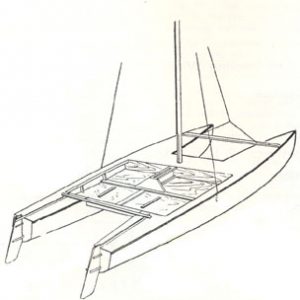
Fast Twin Catermaran
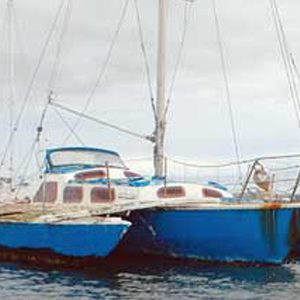
Lively 28 Cruising Trimaran
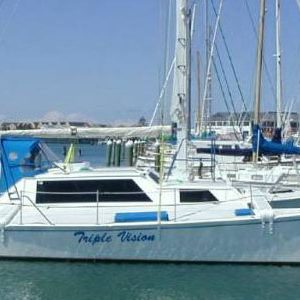
Lively 35 Cruising Trimaran
Building, restoration, and repair with epoxy

Developing Multihulls
A folding trimaran for diy boat builders, by michael leneman, multi marine.
Above: A completed L-37 multihull at the dock. Multi-Marine’s new 23′ folding trimaran kit features manufactured hull pans. The builder attaches plywood topsides to the pans.
What is the simplest way for a home builder to build a good, light hull for a catamaran or trimaran? A few years ago, we set about looking for an inexpensive way to construct a small trimaran that we had developed as a prototype. The answer we came up with was unique: to combine a fiberglass molded “pan” with plywood/glass/epoxy topsides.
It is very time-consuming to build and fair the three hulls of a trimaran. So our concept was to make the exacting, complex curved, below waterline shape of the hull—the pan—in a mold. The simpler, above waterline shape can then be formed in easy-to-make plywood/ composite panels. This combination results in lightweight hulls, which are easy to build. The plywood/composite panels bend to a nice, fair curve so that almost no laborious fairing is required. The pre-molded fiberglass/ epoxy pan is, of course, already fair.
From this concept, Multi Marine’s new 23′ folding trimaran, the L-7, emerged (See image at top) . The home builder can purchase pre-manufactured fiberglass/epoxy-molded pans for the main hull and floats from Multi Marine and then join these to plywood/glass/epoxy topsides he or she builds. (The full kit includes the fiberglass/epoxy pans for the main hull and floats, the glass-pultruded I-beams (tapered), pultruded “C” channel for the x-arm boxes and daggerboard, mast kit, rigging, sails, plywood, fiberglass, and foam. WEST SYSTEM® epoxy, rollers, squeegees, and other accessories can be bought from a local dealer or West System, Inc. The full kit costs less than $19,000, including a mainsail and jib. Any item may be purchased separately.
The floats (amas)
For the floats, the builder starts upside down with the deck and then installs trapezoid-shaped, “picture-frame” bulkheads. The okoume marine plywood topsides, which have already been fiberglassed on the inside, are then installed (Figure 2) . Next, the butt blocks are put in and the fiberglass pan is epoxied in place (Figure 3) . Once that is done, the whole outside of the hull is fiberglassed. An amateur builder can make this float in less than 40 hours. We have built 6 floats like this, and there is virtually no fairing, just some microballoon passes where there is a joint.
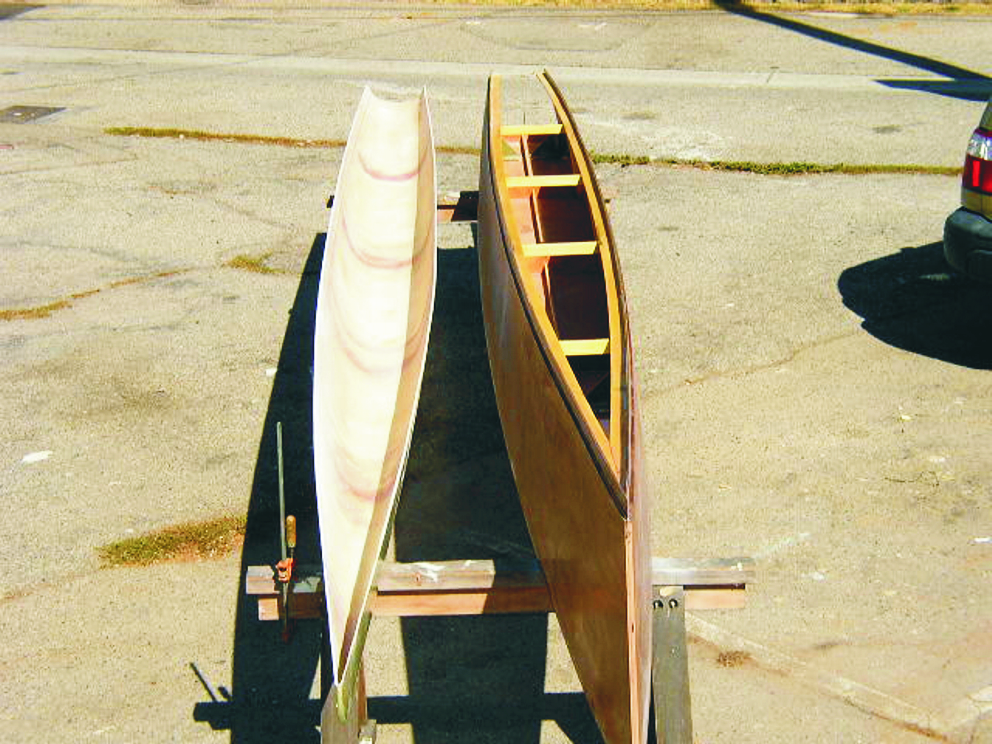
Figure 2—The pan and topsides of the L7 folding trimaran. The plywood topsides have been glued to the bulkheads. The next step is to install the butt blocks, to which the pan will be attached.
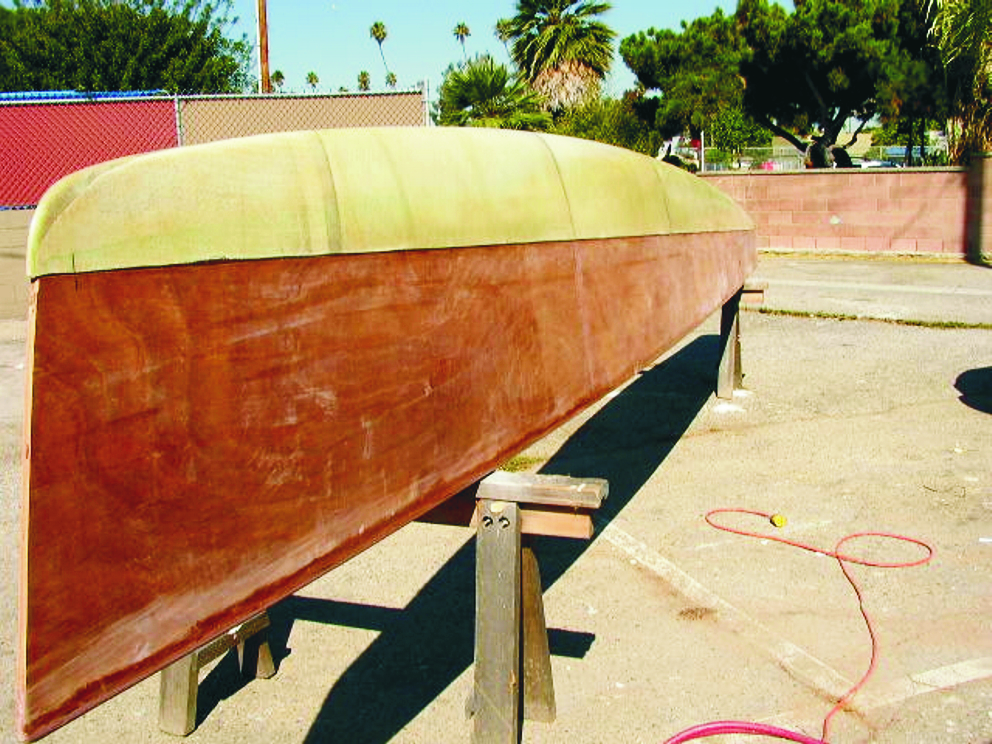
Figure 3—The epoxy/fiberglass composite pan is glued to the topsides. Fairing is required only along the joint before the outside of the float is glassed and coated with epoxy.
The main hull
The main hull (if you’re building a trimaran) is done a bit differently. The full bulkheads for the main hull are built first and placed on a strongback. Then the fiberglass pan is glued to the bulkheads (Figure 4) . The butt blocks are glued to the pan (not the topsides, as in the floats). Lastly, the topsides are put on. After everything is set, the builder turns the hull right side up, levels the sheer, and puts on the decks and cabin. The cockpit floor, decks, anchor locker floor, cabin side seats, and lazarette floor are all flat and are pre-made with foam, glass, and plywood. There is basically an entire mid-height sheer web that runs through the entire main hull.
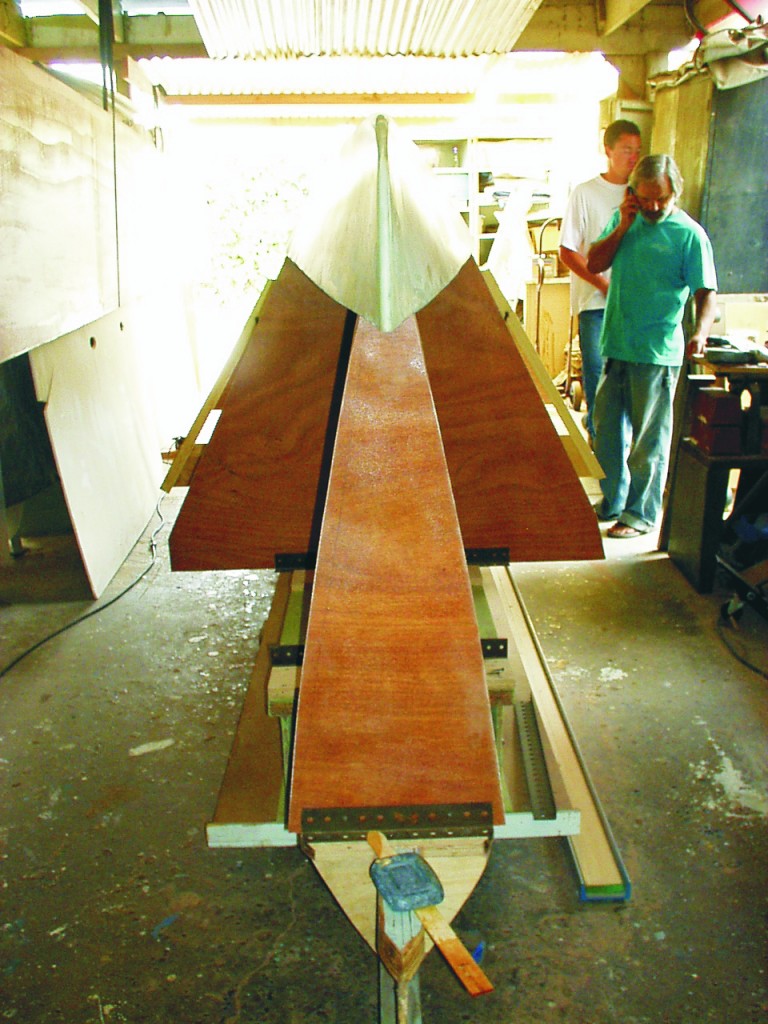
Figure 4—The main hull is built by first attaching bulkheads to a strongback. Here, the pan is glued to the bulkheads before butt blocks are glued to the pan. The topsides are put on last.
For the main hull decks, cockpit floor, anchor locker floor, and seats, we use a combination of thin plywood, styrene foam, and glass. High-density styrene foam is not usually used in custom boat construction because polyester resin eats the foam, and styrene foam is susceptible to pressure dings. However, WEST SYSTEM Epoxy works great with styrene foam, and bonding a thin layer of plywood to the top face of the composite panels eliminates the pressure ding problem. A composite panel made this way (ply-styrene foam-glass) is very stiff and light. The best part is that the cost is about 1/3 that of a standard urethane foam-cored, glass composite panel.
The X-arms are one of the coolest parts we came up with. They are fiberglass pultruded I-beams. The best part is that you can cut the sheer web of the beams and bend the caps down to make a nice looking, tapered, outside shape to the beam. The beams look good, they are pre-made, they can’t corrode, they are strong, you can paint them any color you want, and they are inexpensive.
Rigging and sails
To fill out the rest of the basic boat, we extruded our own mast and designed our own rigging with the added feature of a roller-furling boom. Full-batten mainsails lend themselves to being furled around the boom, especially since we use an inexpensive round aluminum tube as our boom. With a main, jib, and reacher, the boat is about the same speed around the racecourse as a stock F-31 folding trimaran with a full inventory of sails.
The Eko-Cat 23
So, now you’re sitting around looking at the trimaran floats, and you say to yourself, “gee, those would make nice catamaran hulls if they just had a little more freeboard in the transom.” Well, this can be easily done since the topsides of the floats can be changed in a second. It is only the pan/topside joint that has to remain the same. We have made a few small power catamarans from old beach cats, so making the power Eko-Cat 23 from these hulls turned out to be very easy. The mileage is incredible. An 8-hp motor makes 12 knots and over 20 miles per gallon in flat water. With a 25-hp motor, the boat does 20 knots.
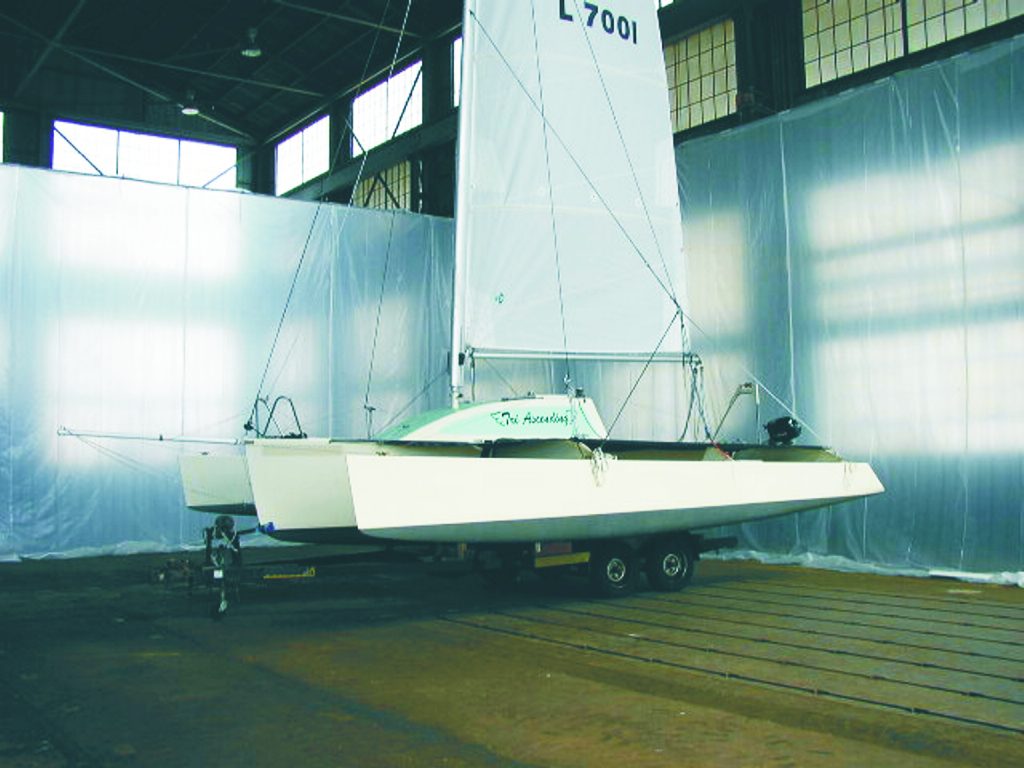
Figure 5—A completed L-7 folding trimaran. When folded, the L-7 is 8’4″ wide and easily trailered.
L-7 Folding Trimaran Specifications
Length: 23′ 6″ Beam: 16′ 6″ Folded beam: 8′ 4″ Mast height: 33′ Sail area (main & jib): 370 sq ft Weight (empty): 1300 lb
For more information on both of these projects, visit Multi Marine .

Barrett M80
DIY tri capturing imaginations
Wayne Barrett has been building boats for 50 years, many of them world renowned. His latest venture is a DIY trimaran kit that embodies his half-century of expertise and celebrates “the joy of building and sailing your own creation”.
Famed in multihull circles and the creator of high profile vessels such as ‘Trilogy’ and ‘Indian Chief’ designed by Tony Grainger, and ‘Traveller’, the 50-foot tri designed by Dick Newick, Barrett describes himself as “a little guy designing boats on the kitchen table in an apartment on the Gold Coast, with a nice view over the lake”.
He has built some “100 or so boats” over the years and his passion and prowess have inspired him to create the M80 trimaran, an 8-metre vessel designed with the home builder in mind; those with limited time or space, and some basic experience with hand tools.
The versatile M80 can be specified for cruising or racing and the larger 9-metre design will have a range enough to sail across the Atlantic.
“In 2021, I’m planning to sail the 8-metre boat up to The Whitsundays as a promotional exercise to showcase the vessel. It’s very manageable for single-handed sailing.”
The concept arose from Barrett’s belief that sailing should be within everybody’s reach.
“I’ve built quite a few complicated, high-performance multihulls over the years and I’m aware they consume time that’s way beyond what an amateur could devote to a build. I used the flat panel concept, adapted to tri design and put it out there for amateur or professional builders.
“A friend of mine I’ve been sailing with for 40 years needed a new modern Buccaneer 24, a plywood 24-foot Crowther around in 1966. I’ve built a few of them, and a B33, B40 and a Spindrift 37. I thought about it for a year or so, then did something about it.
The spiritual successor to the Crowther Buccaneer 24, the 24-ft ‘Mojo’, was originally designed with a central cockpit, a double bunk down aft and a galley and head forward, which I thought was a great concept. But I scrapped that idea and went with a conventional aft cockpit.”
The first boat, in Brazil, set sail just over three years ago and since then, Barrett has sold plans around the world.
“A mate of mine from Geelong, Andrew Johnson, is building one at Lightwave Yachts at Coomera on the Gold Coast with the guidance of Roger Overell. It’s well into the final stages and will be used for cruising. It’s made totally from carbon, so it’s light and strong.
“There’s another one being built in France, a 6-metre design being built in Melbourne and a 9-metre design close to completion in The Netherlands. I’ve sold 9-metre plans to Germany and one in Sydney, revised to be all flat panel, foam and round bilge, with aesthetics to suit that owner.”
The main attributes of the design that have such broad appeal are its simplicity and economical package.
“Initially the concept was built around plywood, which has been a common material for 100 years and most people are familiar with it,” explained Barrett. “The benefit of ply is that a guy can build it in his own shed, over time. But other than the 9-metre in The Netherlands, people are all keen on the foam and epoxy.
“Foam and epoxy is a bit more costly, but comparing the total price is attractive for an amateur builder. It can be built from CNC cut panels in a fraction of the time compared to some other options, alternatively you can build it from our easy to follow plan set for DuraKore, DuFlex or foam core kits.”
Barrett has worked with ATL Composites for the past 25 years on numerous projects, including the 9.2-metre ‘Trilogy’, which held the Aust Championship title for around 10 years, ‘Traveller’ and the 13-metre Gary Lidgard-designed cat ‘Saloon Bar’.
“I also built a 7.5-metre caravan which appeared on the ABC program, ‘New Inventors’ five or so years ago,” continued Barrett. “I used ATL Composites’ products, including foam and resins.
“ATL spent a lot of time scanning the surface of the moulds so we could get an accurate pattern for the shapes of the foam core. I built five of them, all custom designed and built, all traveling the country. It was a fantastic looking thing!
“ATL has always been fantastic to me, in their general support, timely supply of goods, always bending over backwards to help.”
For the M80 in build at Lightwave Yachts, the main shell structure, fore and side decks, and cabin sides were built with DuFLEX/foam panels cored with Divinycell H80 structural foam in a variety of thicknesses and reinforced with double bias E-Fibreglass skins.
The cabin top and floats were strip planked with DuFLEX H80 strips with a 450grm uni-directional on either side to achieve the compound shapes and then reinforced with additional laminates to complete the structure.
The project incorporated carbon fibre and E-fibreglass reinforcement, supplied by ATL, to provide stiffness and to achieve the weight specification for the project.
High performance KINETIX R246TX, a thixotropic epoxy, was used to laminate these reinforcements and WEST SYSTEM R105 and H206 was used for all bonding and coving, combined with WEST SYSTEM 413 Microfibre Blend and 411 Microsphere Blend powder modifiers to alter the consistency for the specific applications.
The M80 was faired with ATL’s unique Technifill XP which is a pre-filled epoxy fairing compound that is ultra-lightweight and very easy to sand.
Getting started is straightforward, according to Barrett. “People buy the plans, complete with DXF files and they can have all the flat components cut out with CNC or jigsaw by hand.
“If you have plenty of time, it’s cheap. An average handyman or woman, with basic experience with hand tools could put it together in their garage or workshop. In The Netherlands it’s being assembled under a tent to keep rain and snow out. Where there’s a will, there’s a way to boat the world over.”
ALSO ON MYSAILING

30 Days Until the Start of the Worrell 1000 50th Anniversary Race


Port Douglas Race Week 2024 – Still going strong after 30 years
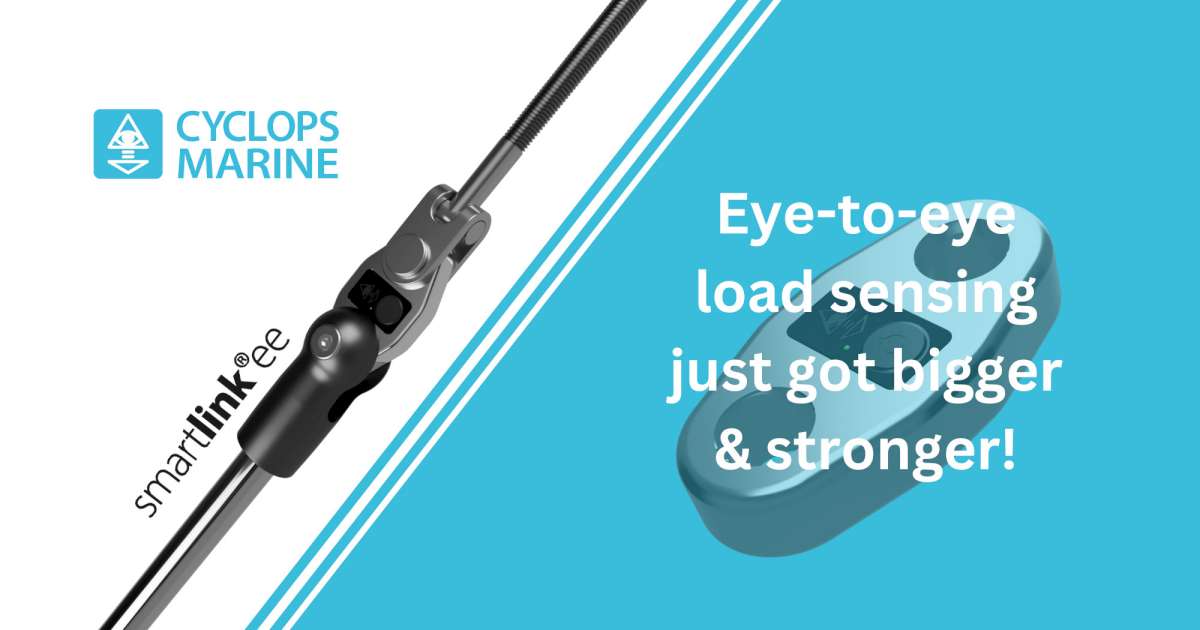
Strong is smart – pin-to-pin load monitoring hits 10 tonnes!

Preview to biggest ever Sail Port Stephens

Superyacht Australia hosts ultimate Endless Summer crew party of the year

GWA Wingfoil – Surf-Freestyle competitors battled it out until the semis

Tom Slingsby has confirmed the team will be on the start line of Bermuda next month

Allegra claims inaugural IMA Caribbean Maxi Multihull Series by a point

Lisa Blair achieves two new records

GSC – Louis Robein assisted by Argentinian Navy

Lagoon Unveils the Lagoon 43 – Could this be the next best-selling catamaran?

Upcoming Big Air Event in France – Your Complete Guide

Join Our Newsletter
- Name First Last
- Phone This field is for validation purposes and should be left unchanged.

Read all of the latest sailing news

Dinghy and Yacht Racing News

News from the offshore world

Cruising Stories from around the world

Boats & Gear
The latest boats and yachting gear

Watch everything sailing and boating
Latest Sailing News, Racing, Cruising, Boats, Gear and more

The challenge of building a trimaran from beachcat hulls
Hi Mike! Let me first say I appreciate the depth of information on your web site :)
I've been ‘oogling’ it for years. But now I have a question regarding the potential of building a trimaran out of some old 18' cat hulls. How would you suggest I proceed and what might I expect from the result ?
….. Josh from Kalispell, MT.
ANSWER : Tks Josh … always pleased to hear my work is proving of value to others.
I first need to say that using cat hulls is not a perfect fit for either the vaka (center hull) or even the amas (floats) but sometimes we can make something work as a fun project. The vaka will be the biggest challenge. I could briefly answer your question with just a list of do’s & don’ts , but I think a more detailed reply will give you some specifics and cover a broader range of related questions, so here we go.
First step is to make a weight estimate starting with what a ship designer would call the “Lightship weight” (boat ready to sail, but no supplies, crew or their personal equipment). You then need to decide what weight you wish to tack-on to form the Design Displacement . This we call the ‘Deadweight’. The very minimum would be for solo day sailing .. say 200 lbs added to the Lightship weight, but for an 18footer, this will likely be more like 350lbs as an absolute minimum.
So let’s assume the boat and its rig and gear weigh 550 lbs. Now with 350lbs added, the required Design displacement will now be 900lbs. The volume to support that will be 900/64 = 14 cu.ft. (1 cuft displaces 64 lbs of seawater, or use 62.4 for fresh water)
The difficulty with a trimaran over a beachcat, is that there is initially only ONE hull to provide this buoyancy volume, compared to two for a catamaran, so right away, one can see why a single catamaran hull is WAY too small for a vaka. Let’s say these are your 3 hulls.
Place the widest one with most volume in the center.

Obviously, if you kept the hull in this level position, your trimaran would be dragging 3 hulls through the water with far more drag than for a catamaran.
So you need to lower the central hull, so that it will support your 900 lbs .. requiring 14 cu.ft volume under the waterline. It will clearly not have the volume needed so what can be done ? There are 3 basic ways to go. You can lengthen it, widen it, or sink it deeper. Using all three would be best if designing a new vaka but I suggest that sinking it deeper will be the easiest, as you can then just raise the sides. But you will probably need some frames to support the deeper hull section as the hull will now have to accept more hydrostatic pressure.
It will now look more like this:
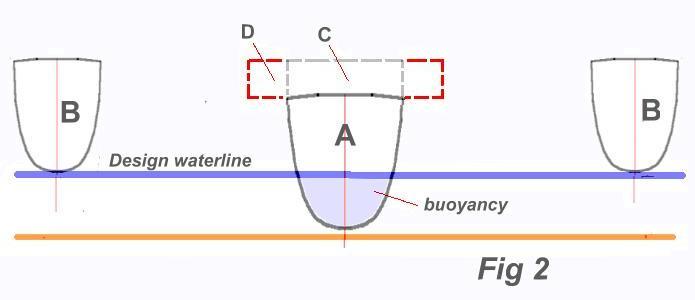
You can either raise the sides (C) or a better solution would be to combine this with side extensions (D) to give yourself some form of central cockpit as well as more width to later attach your cross beams (akas). Exactly how deep this central hull will need to go, will decide how practical this whole ‘conversion’ will be, and it’s quite possible you will need to do some major surgery to this central hull (or build a new one) to get the buoyancy volume you need. If you are not already familiar with how to calculate this, I suggest you study this page from the design section.
https://www.smalltridesign.com/Trimaran-Articles/design/simpsons-rule.html
A very rough idea of the sectional area (marked as ‘buoyancy’ in the above sketch) can be obtained by assuming a Block Coefficient* of 0.5. For this, double your required volume and divide by your waterline length .
- Block Coefficient is the ratio of actual hull volume to an encompassing ‘block’, that has dimensions equal to: your waterline length: your waterline beam: and underwater water depth (design draft)..
So in this case, this will be 2 x 14 / 17.5 or 1.60 sqft, which will roughly require a beam and draft of (1.60 0.5 ) or 1.265 ft for both waterline beam and for draft .
If your hull is much smaller, you either have to go deeper than 1.3ft draft OR find ways to widen that hull to get the cross-sectional area you need. (Typically, a central trimaran hull has a waterline width of about double that of the ama beam).
Moving forward .. let’s assume you now have chosen your best workable solution for the vaka.
As far as the overall beam is concerned, the issues involved and a way to select a suitable beam is already explained in this Q&A from earlier this month.
We now need to connect the amas with the main hull using beams. As I understand you are planning to use a similar folding system to my W17 and using my design of fiberglass hinge and latch , I will explain what you will need.
Beam and latch strength will be defined by the maximum righting moment that the ama can apply, plus a safety factor.
As a safety factor, it is common to apply the full buoyancy of the ama (when fully underwater) to the main beam ... and multiply by the Beam Lever (shown here), which might be ~4ft in this case. IF the full ama volume is say 800 lbs, then the bending moment on the beam would be 3200 lbs.ft
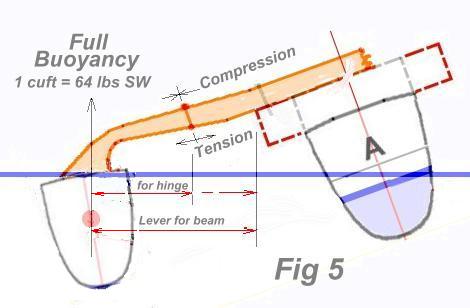
Once you have fixed the hinge location, you can calculate the bending moment at the hinge, using the same 800 lbs (just assumed for this example) but with a smaller lever. Let’s assume it is 2.5ft in this case, so the Bending Moment will now be 2.5 x 800 or 2000 ft lbs. This would mean that IF your vertical distance between the upper hinge and the lower latch is 5” deep (0.42ft), that the latch will need to take 2000/0.42 or 4762 lbs in tension, for the hinge to be as strong as the beam. This shows the important value of 'beam depth' with a hinge system.
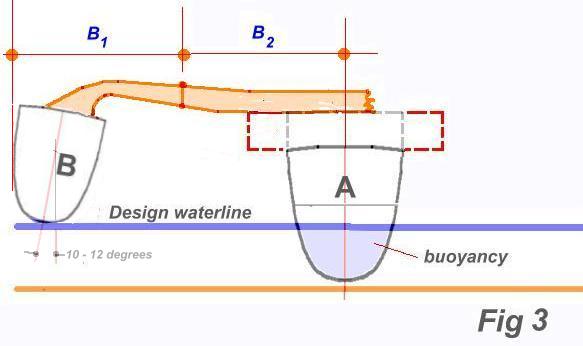
There will also be a download on the upper hinge, due to whatever crew weight you place on the flying windward ama (plus the weight of the ama and outer beam itself). With a large volume ama, this download is typically about 70-80% of the upload, so the hinge is a little less stressed in tension than the lower latch, but with a small ama, it could be the reverse, so you need to do the maths..
In Fig 3. note that I show the amas inclined out at 10-12 degrees. If this is not done, they are more side-loaded when heeled and this adds an unnecessary load to their beam attachment as well as making the ama more resistant to push through the water, so personally, I consider some outward angle is essential.
In addition to their location in the above sectional view, the outer hulls that will work as amas, also need to be positioned in profile view , relative to the central hull.
In the sketch below, they are shown with slight lift of the bow that some designers in the past have incorporated with the assumption of less resistance and 'to ride over the waves'. In the 1970’s many amas were then banana shape d and even back then, Hobie 16 hulls were sometimes used as trimaran floats. Having sailed on one a few times, I found such boats (like Newick’s Tremolino for one) were very jittery in any seaway, were very wet, and also pitched excessively. Even using the straighter and therefore more suitable H18 hulls, their stability role for a trimaran is still compromised if installed as shown here in Fig 6.
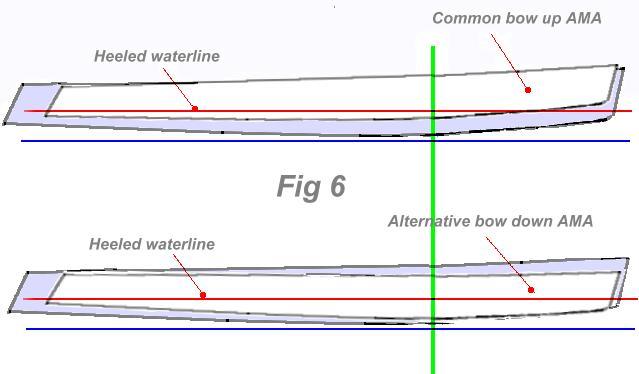
Just compare these two sketches in Fig 7 that both show an identical assumed heeled water line (in red) and you can see that IF the bow of the ama is raised that the ama will not give any bow lift UNTIL the whole bow drops, severely increasing the risk of pitch-poling, so unless the bow is very full with a wide vee, its more effective and safer to actually LOWER the buoyancy of the ama bow so that it quickly immerses, to provide more effective lift when heeled.
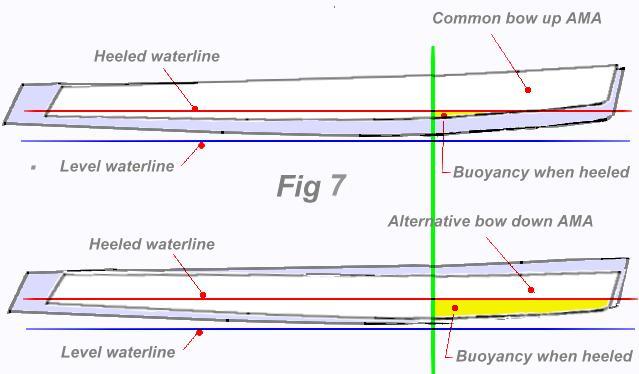
So what can be done to make the beachcat hull more like this ama? The bow is deep and narrow, not vee’d. Think of the Hazelett mooring buoy that is a vertical tube. While it still offers buoyancy, it moves very little in waves. When a bow is like that, its not easily launchied in the air to only fall again, over and over again. It just stays quiet and cuts horizontally through waves and it certainly increases the waterline length. Early rockered amas, had short waterline lengths and were also vee’d … two things I advise against. After all, we are ’sailing’ on this ama and need it to act like an efficient boat hull. But as it would be complicated to deepen the forefoot of an existing beachcat hull, its easier to lower the bow as shown above and then raise the deck forward of the forward beam.
As a picture is a 1000 words …, check out what I would do. 3 days of 4 hours could see both done if you plan your work.
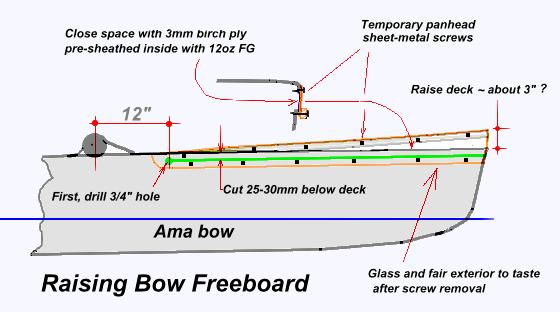
You might find a collision bulkhead inside that will need cutting across, but it should not be hard to raise that with rigid foam, so that the raised deck can be bonded to it and keep it watertight. The ¾” holes in the sides will stop the end of the cut from splitting and cracking, and will be filled and covered over by the fill piece.
This should give one enough to make the important decisions and calculations, but as can be seen, catamaran hulls are not ideally interchangeable with Trimaran hulls, so their use like this will always be a compromise.
You also have to decide which hull will hold a centerboard or daggerboard. It’s much easier to reach one in the center hull, but this is your choice and dilemma. Either can be made to work but do not use ama boards unless you are operating in deep water, or you may end up IN the water while trying to adjust them from an ama, especially in rough water.
As far as the end result , it depends on so many things that it’s hard to predict. But it could be made to perform quite well in relatively flat water and give you some fun at least … but it will not be a dry boat like the W17, nor as comfortable or have as low leeway, as the round hulls are just not as ideal for slicing waves with minimum disturbance as the W17 hulls are. While rounded hulls are very effective in lowering surface friction, they seldom slice waves as well and certainly do not provide the leeway resistance of the W17 hulls.
It's also frequently forgotten (or just not understood) that often, the greatest resistance from a small boat is wave resistance or wave making … being the most critical in the 4 to12kt range. Optimizing for this range with non-round hulls can more than make up for their added skin drag. See this article for more on this, where there is a chart showing what proportion of residuary (wave) resistance applies at what speed.
Hope this helps to get you going in the right direction, and good luck with your project.
Also note that there was an earlier question of using the reverse ... Trimaran hulls for a Catamaran and as my graph showing the proportion of residuary resistance versus the total is also there, it may be of some interest too.
Mike ... March 2022
"New articles, comments and references will be added periodically as new questions are answered and other info comes in relative to this subject, so you're invited to revisit and participate." —webmaster
"See the Copyright Information & Legal Disclaimer page for copyright info and use of ANY part of this text or article"

[{{{type}}}] {{{reason}}}
{{texts.summary}} {{#options.result.rssIcon}} RSS {{/options.result.rssIcon}}
{{{_source.title}}} {{#_source.showPrice}} {{{_source.displayPrice}}} {{/_source.showPrice}}
{{{_source.displayUrl}}}
{{{_source.displayDate}}}
{{{_source.description}}}
{{#_source.additionalFields}} {{#title}} {{{label}}}: {{{title}}} {{/title}} {{/_source.additionalFields}}
Discovery 20 Trimaran
See Discovery 21 .
The Discovery 20 trimaran is a fast, fun daysailer with the potential to be a camper/cruiser for the adventurous. The D 20 design has been updated as an exciting and powerful new daysailer. It is available as a kit or a complete boat. This design is intended for enjoyable day sailing, although there is space below deck for camping gear. There is a 7' by 7' cockpit that is roomy for 4. You sit upright, with a backrest, not sprawled on a trampoline. My 75 year old mother-in-law found the boat very comfortable. The D-20 is quite fast; the all up weight of the boat is 527 pounds. She utilizes a daggerboard, a rotating aluminum mast and streamlined crossbeams. Construction is wood/epoxy/glass composite.
I really never appreciated how fast the Discovey is until about 10 years after she was designed when I raced mine in a Wednesday night yacht club series against a new Newick 24' trimaran (longer, wider, taller rig, new laminate sails). The other boat was sailed by a very experienced sailor and I was expecting to get my butt kicked. During the first upwind leg (in about 8 knots breeze) the Discovery 20 blew everything away, including a fleet of Etchells. I was so impressed I hove to at the weather mark and waited for the other tri to catch up so that I could get a better comparison on the down wind leg (he had a spinnaker I didn't). As expected, I lost some ground here but not really that much, and I was able to get it all back on the next upwind leg.
Design Archive
- Atlantic 50
- Atlantic 46
- Atlantic 48
- Atlantic 55
- Atlantic 42
- Buzzards Bay 34
- Juniper, Juniper II
- Hammerhead 34
- Hammerhead 54
- Explorer 44
- Sky Hook 39
- Discovery 20
- Superior 54
- Charter Cat 65

6 Best Trailerable Trimarans For Bluewater and Coastal Sailing

As an Amazon Associate, we earn from qualifying purchases. We may also earn commissions if you purchase products from other retailers after clicking on a link from our site.
Having a boat costs a lot of money, even when you are not using it, marina fees, etc. And once it is in the water most sailors never go very far from their “home marina” and sailing will be somewhat restricted. However, what if you could fold your trimaran and put it on a trailer, store it at your house, and go to a new sailing spot the next time?
Here are 6 of the best trailerable trimaran:
- The Dragonfly series
- Corsair Series
- Windrider 17
Choosing the best trailerable trimaran (a multi-hull with three “hulls”) will depend on crucial factors like speed, durability, design, and ease of transportation. This article is here to help you get started with your research and hopefully help you on the way towards your dream boat!
Table of Contents
Cruising Trimarans That Can Be Transported
Cruising boats are made for multiday sailing either on the coast of your favorite sailing area or full-out blue-water ocean crossings. Extended living should be a priority in these designs.
1. The Dragonfly 25 and 28 (Dragon Fly Series)
Dragonfly is in the business of making the “best foldable trimarans on the planet” many would agree with this statement. Dragonfly is known for its commitment to easy trailering and ease of use, shown in designs for the Dragonfly 25 and Dragonfly 28.
The “Swing Wing” system on the linchpins is one of the key features of the dragonfly series. The system’s application makes it possible for the trimaran to narrow its beam as much as 50%.
Attesting to its Scandinavian manufacturing, most parts of the trimaran are made in-house. This guarantees quality and ensures that all used parts are above standard.
You don’t need to look further than the Dragonfly 25. Its centerboard slightly offset to port. Extra space is created in the main hull’s interior with a trunk buried under a settee. Performance-wise, the low drag and narrow hull shape allow the boat to reach blistering speeds.
Dragonfly 28 In Numbers
- Length: 8.75m
- Beam folded: 2.54m
- Max crew: 5-7 people
- Max Speed: 22+knots
Dragonfly 25 In Numbers
- Length: 7.65m
- Beam folded: 2.30m
- Max crew: 4-6 people
- Max Speed: 21+knots
2. Farrier F-22
New Zealand enters the trimaran manufacturing race with this premium sea goer. The vessel comes in two different versions: a performance variation with more horsepower and a full cabin cruising version.
Compared to the dragon series the F-22 has the biggest allowance for space.
The F-22 is known for being one of the easiest trimarans to fold and load.
The sports version of the F-22 has some really good performance to offer. It has an aggressive spirit: you can mount a sail while leaving plenty of space for the boat’s fine entry and flared forward sections. The build quality is also topnotch—a lasting memorial to a principle that Ian Farrier always worked by: excellence.
Farrier F-22 In Numbers
- Length: 7.0m
- Beam folded: 2.5m
- Max crew: 3-5 people
- Max Speed: 20+knots
3. Corsair Series
This boat series has an exciting history. Farrier created it to promote his trailerable tri concept. However, the series is now independent with a top-class vehicle to its name.
The Corsair 760 is listed as providing some of the best performance and safety benefits to sailors.
Building off the spirit of excellence of the founder, the Corsair 760 has created a boat with comfort and racing potential. The boat can be tricky to handle at first, but it will be a breeze once you get the hang of it.
It is also worth noting that the corsair 37 is the largest trailerable trimaran on the market today.
Daysail Trimarans That Can Be Transported
Boats that are made for dayssailing are usually smaller, cheaper and more easily handled. They are perfect for those looking to enjoy a full day on the water in calm weather, but are usually less suitable for multiday events or rough sea sailing.
4. The Astus Models (20ft, 22.5ft, and 24ft)
If you’re looking for something small but still capable of doing day sailing, this 22.5-foot trimaran is for you. Built for speed and maneuverability, the Astus 22.5 has optional foils to optimize speed.
The modern design, coupled with the spacious interior, can fit up to four beds. Accordingly, this trimaran is suited for family outings.
The Astus brand specializes in transportable trimarans, worth noting is that some models need a specific trailer whilst the smaller boats use a standard trailer.
5. Weta 14.5
The 2019 Weta trimaran is a 14.5-foot (4.4-meter) trimaran featuring a carbon frame, centerboard, rudder foil, and rudder shock. The hull is made from fiberglass and foam. The Weta is built for strength and speed based on these lightweight materials.
The 2019 Weta trimaran is easy to sail and is worth considering whether you want to take a quiet sail, race with your friends, or take kids to a sailing lesson. It has a simple design and is easy to set up independently.
The small size makes it more suitable for daysailing in good weather rather than multiday cruising, although more experienced sailors will of course push the limits of this boat.
6. WindRider 17
The 17.4-foot (5.3-meter) WindRider 17 is one of the more versatile trimarans in the market. It packs high performance for a low cost. This trimaran has a light rotating mast to boost performance, and a full-battened mainsail optimizes visibility.
This sailboat is made from rotomolded polyethylene, which is more durable than fiberglass and demands less maintenance.
The WindRider 17 has a comfortable interior and can fit six adults. This is an ideal choice for social sailing for a couple or a family and friends. It’s easy to ride, and a shallow draft allows easy maneuverability.
What’s the Largest Trailerable Trimaran?
The largest trailerable trimaran is the Corsair 37 , this multihull is built for single-handed cruising while still maintaining the ability to comfortably seat 6 people.
The Corsair 37 provides comfort, speed, and safety. It also contains just enough space to accommodate amenities like a propane stove, a sink, and other equipment.
The vessel is designed to be a performance cruiser. It features an aluminum rotating wing mast, carbon fiber bowsprit, and premium deck hardware. The corsair can still cut through the water with ease despite its size, putting the wind in your sails.
What Is a Catamaran?
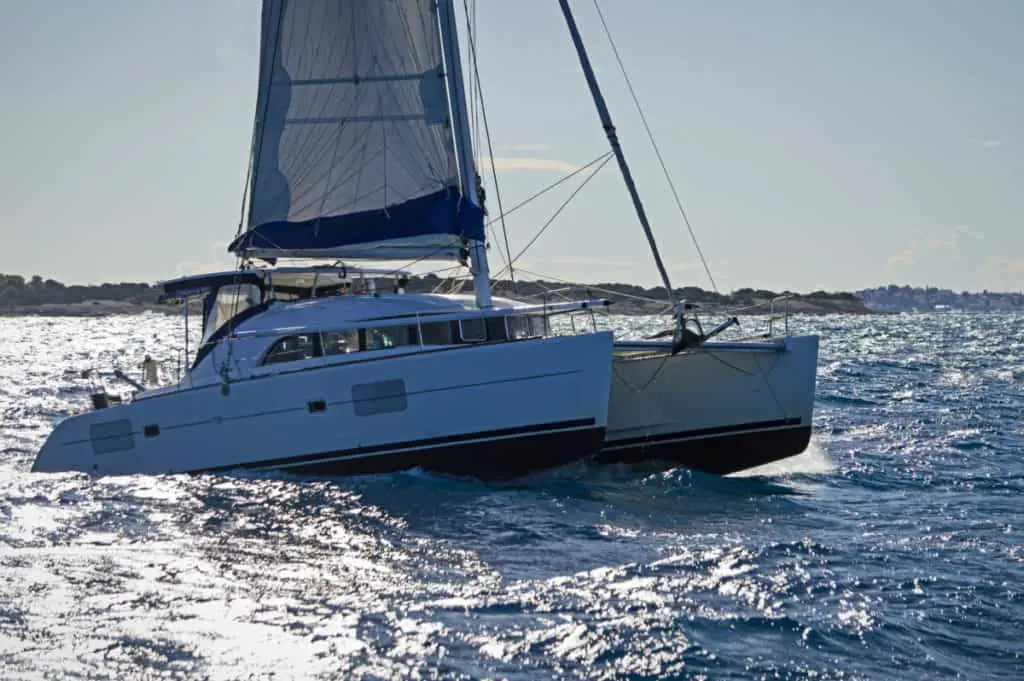
A catamaran is a boat with two hulls (a trimaran has three) connected by a bridge deck. Catamarans usually offer more space than both monohulls and trimarans of the same length. The catamaran is usually somewhat slower than a trimaran but faster than a monohull. They are usually made of fiberglass or carbon fiber.
Catamarans come in all shapes and sizes. You can find straightforward sailing catamarans, perfect for those who are only starting their sailing journey. Larger sailing catamarans have become extremely popular for long-distance sailing.
There are also power catamarans, they have huge diesel-powered engines (sometimes electric) and no sails. Also called “power cats”, these boats can reach 30+kts.
Can a Trimaran Be Trailerable?
As discussed above, some trimarans are possible to put on a trailer and move to another sailing area or to be stored at home. This is usually not possible with catamarans but is sometimes possible with the trimarans that are fitted with foldable amas (the two outer “floats” or “hulls”).
Some trimarans can be trailerable, this is mainly due to the ability to drastically decrease the vessels beam, sometimes as much as 50%. This allows the trailer plus trimaran to be below the legal requirements of the road.
Final Thoughts
It has proven difficult to beat the trimaran in terms of speed. Through the ages, this type of vessel has proven to be immensely enjoyable in all kinds of sailing activities. These can range from sea adventures to waterborne relaxation in your free time.
Trimarans come in various types, foldable, for cruising or racing, etc. However, there is a common factor: many of the small ones are trailerable. This makes them easier to move than most other types of boats.
Owner of CatamaranFreedom.com. A minimalist that has lived in a caravan in Sweden, 35ft Monohull in the Bahamas, and right now in his self-built Van. He just started the next adventure, to circumnavigate the world on a Catamaran!
Leave a Reply Cancel reply
Your email address will not be published. Required fields are marked *
Save my name and email in this browser for the next time I comment.
Recent Posts
Must-Have Boat Gear for Catamaran Sailors!
Sailing is probably the most gear-intensive activity I've ever done; there are so many decisions to be made about what gear to buy now, for tomorrow, and what to definitely never buy. The gear on...
What Kind of Boat Is The Best Liveaboard? Trawler, Monohull, or ...?
Living in a boat can be a thrilling, once-in-a-lifetime experience; however, knowing how to choose the right vessel to sustain the lifestyle you want to achieve can be crucial in making the most out...
- Architectural
- Transportation
- Duflex Balsa
- Duflex Foam
- DuFLEX Coosa
- DuFLEX Strips
- Featherlight
- Optimised Kit Technology
- CNC Routed Kits
- High Density Inserts
- Full Sized Components
- FRP Bonding Angles
- Processing E-glass Laminates
- Secondary Bonding
- Bonding Angle Data
- DuFLEX vs Aluminium
- European Manufacture

(07) 5563 1222
M-Series Trimaran M80 MKII
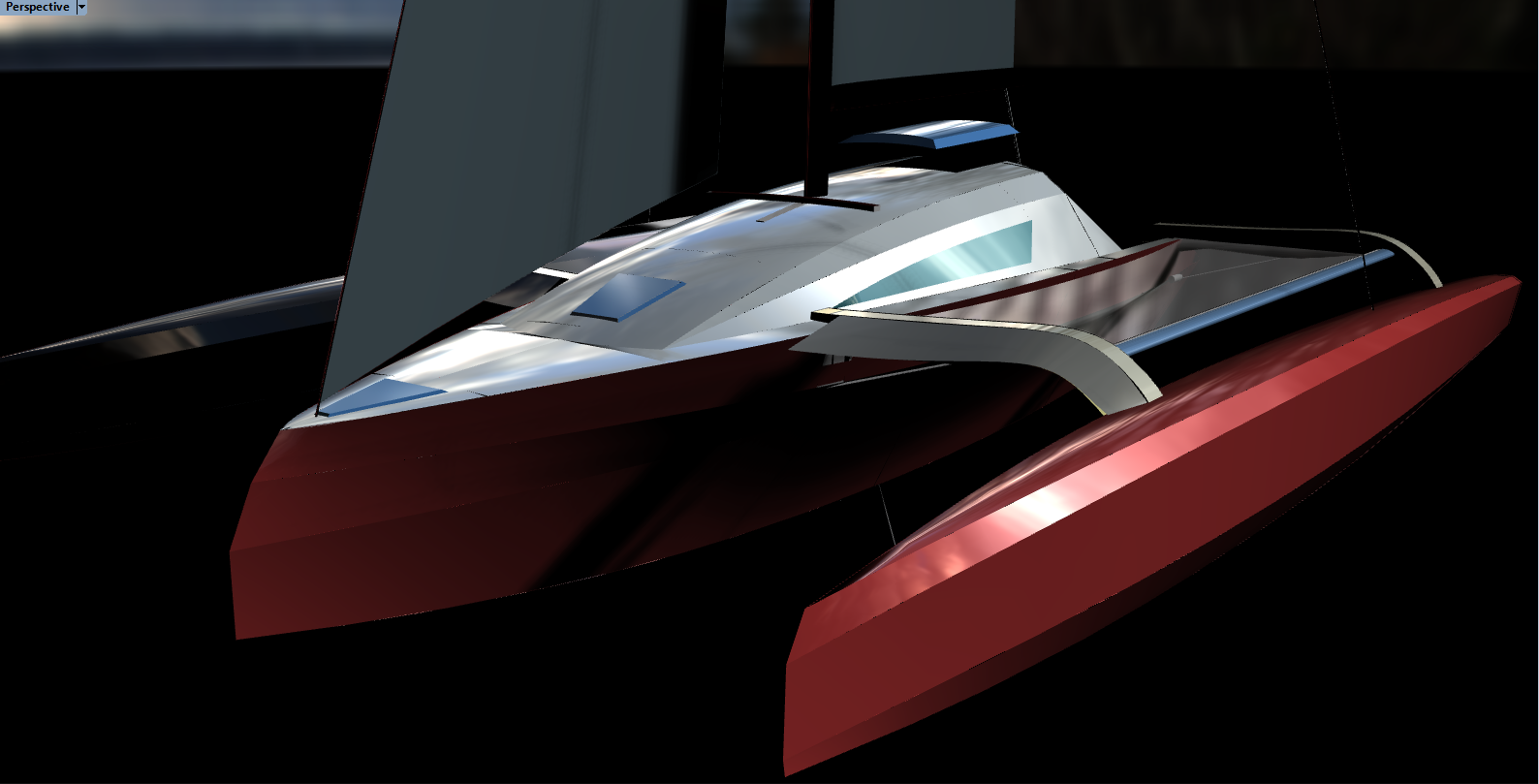
Wayne Barrett has been building boats for 50 years, many of them world renowned. His latest venture is a DIY trimaran kit that embodies his half-century of expertise and celebrates “the joy of building and sailing your own creation”.
Famed in multihull circles and the creator of high profile vessels such as ‘Trilogy’ and ‘Indian Chief’ designed by Tony Grainger, and ‘Traveller’, the 50-foot tri designed by Dick Newick, Barrett describes himself as “a little guy designing boats on the kitchen table in an apartment on the Gold Coast, with a nice view over the lake”.
He has built some “100 or so boats” over the years and his passion and prowess have inspired him to create the M80 trimaran, an 8-metre vessel designed with the home builder in mind; those with limited time or space, and some basic experience with hand tools.
The versatile M80 can be specced for cruising or racing and the larger 9-metre design will have a range enough to sail across the Atlantic.
“In 2021, I’m planning to sail the 8-metre boat up to The Whitsundays as a promotional exercise to showcase the vessel. It’s very manageable for single-handed sailing.”
The concept arose from Barrett’s belief that sailing should be within everybody’s reach.
“I’ve built quite a few complicated, high-performance multihulls over the years and I’m aware they consume time that’s way beyond what an amateur could devote to a build. I used the flat panel concept, adapted to tri design and put it out there for amateur or professional builders.
“A friend of mine I’ve been sailing with for 40 years needed a new modern Buccaneer 24, a plywood 24-foot Crowther around in 1966. I’ve built a few of them, and a B33, B40 and a Spindrift 37. I thought about it for a year or so, then did something about it.
The spiritual successor to the Crowther Buccaneer 24, the 24-ft ‘Mojo’, was originally designed with a central cockpit, a double bunk down aft and a galley and head forward, which I thought was a great concept. But I scrapped that idea and went with a conventional aft cockpit.”
The first boat, in Brazil, set sail just over three years ago and since then, Barrett has sold plans around the world.
“A mate of mine from Geelong, Andrew Johnson, is building one at Lightwave Yachts at Coomera on the Gold Coast with the guidance of Roger Overell. It’s well into the final stages and will be used for cruising. It’s made totally from carbon, so it’s light and strong.
“There’s another one being built in France, a 6-metre design being built in Melbourne and a 9-metre design close to completion in The Netherlands. I’ve sold 9-metre plans to Germany and one in Sydney, revised to be all flat panel, foam and round bilge, with aesthetics to suit that owner.”
The main attributes of the design that have such broad appeal are its simplicity and economical package.
“Initially the concept was built around plywood, which has been a common material for 100 years and most people are familiar with it,” explained Barrett. “The benefit of ply is that a guy can build it in his own shed, over time. But other than the 9-metre in The Netherlands, people are all keen on the foam and epoxy.
“Foam and epoxy is a bit more costly, but comparing the total price is attractive for an amateur builder. It can be built from CNC cut panels in a fraction of the time compared to some other options, alternatively you can build it from our easy to follow plan set for DuraKore, DuFlex or foam core kits.”
Barrett has worked with ATL Composites for the past 25 years on numerous projects, including the 9.2-metre ‘Trilogy’, which held the Aust Championship title for around 10 years, ‘Traveller’ and the 13-metre Gary Lidgard-designed cat ‘Saloon Bar’.
“I also built a 7.5-metre caravan which appeared on the ABC program, ‘New Inventors’ five or so years ago,” continued Barrett. “I used ATL Composites’ products, including foam and resins.
“ATL spent a lot of time scanning the surface of the moulds so we could get an accurate pattern for the shapes of the foam core. I built five of them, all custom designed and built, all traveling the country. It was a fantastic looking thing!
“ATL has always been fantastic to me, in their general support, timely supply of goods, always bending over backwards to help.”
For the M80 in build at Lightwave Yachts, the main shell structure, fore and side decks, and cabin sides were built with DuFLEX/foam panels cored with Divinycell H80 structural foam in a variety of thicknesses and reinforced with double bias E-Fibreglass skins.
The cabin top and floats were strip planked with DuFLEX H80 strips with a 450grm uni-directional on either side to achieve the compound shapes and then reinforced with additional laminates to complete the structure.
The project incorporated carbon fibre and E-fibreglass reinforcement, supplied by ATL, to provide stiffness and to achieve the weight specification for the project.
High performance KINETIX R246TX, a thixotropic epoxy, was used to laminate these reinforcements and WEST SYSTEM R105 and H206 was used for all bonding and coving, combined with WEST SYSTEM 413 Microfibre Blend and 411 Microsphere Blend powder modifiers to alter the consistency for the specific applications.
The M80 was faired with ATL’s unique Technifill XP which is a pre-filled epoxy fairing compound that is ultra lightweight and very easy to sand.
Getting started is straightforward, according to Barrett. “People buy the plans, complete with DXF files and they can have all the flat components cut out with CNC or jigsaw by hand”.
“If you have plenty of time, it’s cheap. An average handyman or woman, with basic experience with hand tools could put it together in their garage or workshop. In The Netherlands it’s being assembled under a tent to keep rain and snow out. Where there’s a will, there’s a way to boat the world over.”
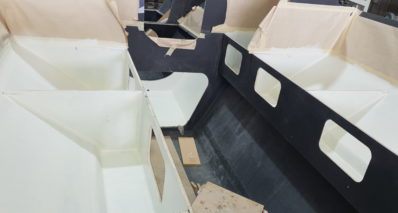
Log in or Sign up
You are using an out of date browser. It may not display this or other websites correctly. You should upgrade or use an alternative browser .
Non-foiling trimarans under 20'
Discussion in ' Multihulls ' started by Tom Makes Things , Sep 25, 2019 .
Tom Makes Things Junior Member
I've been doing research on the options for building a small trimaran under 20' that can carry 2 people (more or less). I'd like to summarize what I've learned and see if it fits with the general consensus. I'm no expert, and I welcome all advice from those with more experience than I. Seems like we can break up this category of sailboat into 3 main branches: 1) Triple Hotdogs: Long skinny shaped central hulls with long amas, sometimes with auxiliary propulsion like Hobie Mirage drive, pedal/prop drive, oars or paddles. Benefits to this design are lighter weight, easier paddling, better in light winds, lower cost to build/own. Drawbacks are limited weight capacity, lower top speed, wet ride. Boats in this category include: Hobie Tandem Island Metz TriRaid 560 Metz Boats - Triraid 560s Trimaran http://www.metzboats.de/htm/designs/multihulls/triraid560s/triraid560s.htm Frank Smoote's Slingshot 19 New Page 1 http://www.diy-tris.com/2012/11-19-footer.htm 2) Skiff with Training Wheels: Wider planing central hulls with low volume amas mounted higher that act more like training wheels for a sporty skiff or dinghy. Benefits are more weight carry capacity, faster top speed when planing, more exciting to sail. Drawbacks are- heavier than above, still a wet ride, lesser performance in light winds, slow below planing speed, and difficult to paddle/peddle. Are they better at pointing due to being sailed like a monohull? Boats/Projects in this category include: Weta: Weta Trimaran - Wikipedia https://en.wikipedia.org/wiki/Weta_Trimaran Sea Rail 19: http://www.searail19.com Astus 6.5: Astus 16.5 http://www.astusboats.com/astus-16-5-copie.html ISO Skiffmaran: ISO Skiffmaran https://www.boatdesign.net/threads/iso-skiffmaran.56971/ I14 Training Wheels: I14 training wheels http://forums.sailinganarchy.com/index.php?/topic/208203-i14-training-wheels/ 3) The original: Wider planing central hulls with larger volume amas that provide greater righting moment. These boats might have higher freeboard, small cuddies or cabins. Benefits include more carrying capacity, dryer ride, higher top speeds? Drawbacks are heavy weight, high cost to build, difficult to paddle/peddle, slower in light winds than #1 due to weight. Richard Woods Strike 15 Sailing Catamarans - Strike 15 trimaran performance daysailer http://www.sailingcatamarans.com/index.php/designs-2/27-trimarans-under-25/223-strike-15-trimaran W-17 W17 Trimaran | Main Page https://smalltridesign.com/W17/greybox/W17-Trimaran.html Can anyone add to my list and or correct my assumptions? Thanks very much. -Tom
Richard Woods Woods Designs
I'd class my Strike 15 in the narrow hull category. And I'd suggest the Strike 20 as more suitable for you Richard Woods of Woods Designs www.sailingcatamarans.com
upchurchmr Senior Member
The wide central hull doesn't affect stability much, the fact that the ama or outrigger is so far off to the side is most of the influence. A wide central hull is mostly for accommodations.
Dolfiman Senior Member
For the comparaison, I would also use the ratio Ama volume (liter) / [ light weight equiped + average targeted payload (e.g. 2 persons ~ 150 kg)] (kg) . Examples : ** For the Triraid 560 : Light weight equiped = 110 kg Ama volume = 180 liter >>> 180 / (110 + 150) = 0,69 ** For the Astus 16,5 : Light weight equiped = 210 kg Ama volume = 500 liter >>> 500 / (210 + 150) = 1,39 Triraid 560 will be little powerful, cannot sail with the a full flying central hull, but its capsize mode will be around the central hull (ratio < 1) , more easy to prevent. A boat oriented to raid sailings without high speed objective. And lighter to trail, to launch. Astus 16,5 will be more powerful, up to sail on the leeward ama alone. But its capsize mode around the ama (ratio > 1) can be more brutal , and finished upside down (critical if the waterdepth is lower than the mast height). Twice heavy than the Triraid (210 / 110), but the Astus 16,5 can be sailed quietly, reversely the Triraid cannot be hard sail because the limited volume of its ama. The Astus 16,5 is more relevant in your cat. 3 although the central hull is not specially wider planning, she is more like a baby oceanic trimaran racer. In your cat. 2 skiff with training wheels, when the amas are high enough for a sail on the central hull only, the ratio can be < 1 as the power (the RM) comes from the crew in hiking posture and the amas are for extra stability when necessary (more often during tacks , gybes, than for gust of wind).
Another example of skiff wider planing with training wheels, the Epoh, but for me can hardly be named a trimaran :
Doug Lord Flight Ready
Just out of curiosity : why non-foiling?
My list has grown since the original post, as has my understanding of some of the hull designs. I'd like to at least have a passenger with me, so I've removed boats that are too small for my needs, though you can argue that some of these are still too small to offer good performance with 2 onboard. My newly silly renamed categories: "Triple Pickles": Canoe/Kayak with floats- these are mostly lighter weight, carry less payload, and sometimes can be paddled, peddled, or rowed for auxiliary power. Generally it's sailed while sitting in the boat facing forward, which in some cases allows for a spray skirt or dodger to keep the spray down. Some love the "armchair sailing" experience, while other folks find the limited seating options uncomfortable. You can't really hike out, at least not if you are steering, as most steer with foot pedals. Commercial offerings include: Hobie Tandem Island, Windrider 17 Buildable plans include: TriRaid560s (though it doesn't really support 2 people very well), TriRaid 620 (prototype), Slingshot 16 Tandem, Slingshot 19 "Jack LaLanes": Narrow at the waterline, but usually with a larger cockpit- these are generally heavier than the pickles, allow for more seating positions, and rarely have a human power option. Some have small cabins. All are designed so you sit "on" rather than sit "in" them. Commercial offerings: Pulse 600, Robinson 5000, Ninja Spider, Astus 16.5 Buildable plans include: Strike 15, Strike 16, Strike 18, W17, Trikala 19, Scarab 16, Scarab 18, Sardine Run, TC601 "Kardashians": Wide planing central hull, similar to a sportboat with training wheels. Commercial offerings: Weta? Epoh?
kleppar Junior Member
Thanks for useful categorization, although as a Norwegian, I have no idea what these names indicate.....I used to own an Adventure Island (category 1); it was extremely wet, but great fun; forward facing was OK when combining paddling and sailing, but uncomfortable for sailing. I sold it after a few years.... Category 3 boats - most of them seem to be sporty and wet, offering very little comfort for the cruising sailor. Category 2 seems to me to be the best compromise when you want to combine performance, cruising, reasonable payload and comfort. Here is one more candidate: Kanka 14 , by the designers of Pulse 600. As I belong to category 2 ("Jack LaLanes"), I seem to have three worthy candidates: W17, Astus 16.5 and Kanka 14.
More info about Kanka 14, proto under construction by Nicolas Arnoult, but not yet photo available (?) : PressReader.com - Your favorite newspapers and magazines. https://www.pressreader.com/france/voile-magazine/20190809/282037623779301
I received some building photos from the designer (I need his permission in case of publishing). This is the ply epoxy prototype. I have been told price around € 15,000.
patzefran patzefran
kleppar said: ↑ I received some building photos from the designer (I need his permission in case of publishing). This is the ply epoxy prototype. I have been told price around € 15,000. Click to expand...
I do not think the design brief for Kanka was racing - it is mainly for pleasure.
Kleppar, What boat are you talking about?
In my last message I was talking about Kanka 14. As you can see, I am interested in a proper trimaran ("category 2"), and I have so far identified three good candidates - Kanka 14, W17 and Astus 16.5.
- Advertisement:
The picture of the Kanka is pretty. I hope the ama bows are not so fine, they are needed thicker to prevent nose diving while reaching. And I hope you will have trampolines outboard of the seating. Heavy is not so good. I assume you have to dis-assemble the boat to transport it?
Ultra lightweight deck+Nonskid DIY style...
drag vs global strength - cat vs tri (non ILAN) or even quad
Dual Route du Rhum winner Laurent Bourgnon lost in diving accident
Yvan bougnon's circumnavigation in a beach cat project.
Scale up a Tornado for Round the World Non Stop
Home built foiling tri
Early UK foiling cats and tris, Mayfly and Force8
Foiling Cat Project
Has anyone seen this foiling cat before.
Foiling modification to a Corsair F28 - anyone tried it ?
- No, create an account now.
- Yes, my password is:
- Forgot your password?


Professional BoatBuilder Magazine
Folding multihulls.
By John Marples , Jan 28, 2023
Folding multihulls and their beam-reduction strategies.

A Farrier 33R trimaran with amas folded and secured on a road-legal trailer exem- plifies the advantages of adjustable- beam multihulls, which are easy to trans- port and store out of the water.
“I’ll be surprised if you can find space in the harbor for that thing,” I heard him say as my new 37 ‘ (11.3m) trimaran was about to be launched. I hadn’t given it much thought, but now this legitimate question was raised, and where to moor was the next issue at hand. Space, particularly width of a slip, becomes the limiting requirement. But then, space also is one of the attractive features of multihulls—deck space to move around on, free from the confines of the cockpit.
Step aboard any multihull and it is obvious how much real estate they offer. Even small models seem expansive. The beam of the typical catamaran is half its length, and trimarans are even wider, sometimes as wide as they are long. Aside from increasing space, beam also boosts stability without adding ballast. The early Pacific Islanders created these form-stable craft for fishing and interisland commerce and voyaging where natural island harbors were few, so the boats had to be light enough for crew to carry them up the beach. Today’s modern multihulls are still lighter than contemporary monohulls, but the larger ones preclude the option of dry sailing them from the beach. They require more marina space than monohulls, and the limited number of slips to accommodate them can be a problem. As someone once put to me, “Multihulls have a poor ‘stacking factor.’”
With catamarans and trimarans becoming more popular, they demand mooring solutions. Some marinas offer shallow-water slips to multihulls, typically at the inboard ends of docks, next to the seawall, because multihulls either have shallow keels or retractable boards. Some marinas also designate the end ties as multihull slips in areas not used for transients. Even though these boats protrude farther into the channel than monohulls, the extra space their beam occupies is relatively small. With multihulls crowding waiting lists for marina slips, builders were prompted to consider folding systems to “improve their stacking factor.”
Without ballast, smaller multihulls up to about 30 ‘ (9.1m) can be dry-stored on a trailer, and most launch ramps easily accommodate over-width boats. If the boat’s beam can be reduced to the legal highway width of 8.5 ‘ (2.6m), the owner can store the boat at home. Today, folding trimarans and catamarans are common sights on trailers in storage yards and backyards. Various folding systems have evolved to support this need, especially for the backyard builder. Some beam-reduction systems allow the boats to be folded and stored in the water in conventional-size marina slips, while other systems facilitate efficient storage or provide street-legal trailering.
Folding Systems
Basic folding systems are separated into several categories:
- take-apart akas, the simplest beam-reduction method
- telescoping akas (sliding beams)
- simple horizontal hinge
- complex horizontal hinge systems
- vertical hinges (swing wing)
- complex swing wing
The following overview of folding systems illustrates how these mechanisms work. It is not intended to be an exhaustive listing of available folding designs. I’ll address two-hull boats (catamarans and proas) first, followed by trimarans. Each type has its challenges and advantages. All are separated into two more categories: transportable boats and trailerable boats. The characteristic distinguishing between them is the time and effort required to launch, starting from an on-the-trailer folded condition. Trailerable implies the possibility of daily launching, requiring less than an hour from trailering to sailing. Transportable denotes a road-legal trailer package but with a longer assembly time to sail away. It might even take more than one trailer load, and considerable assembly time. Legal width in this category could extend to 10 ‘ (3m) wide if OVERSIZE LOAD signs are used (consult local laws). Transportable boats usually require seasonal transport with storage in the water during sailing season and dry storage in the winter. Both categories benefit from the ability to “go to weather at 65 mph” to reach any suitable launching site, even hundreds of miles from home. This opens the possible sailing venue to any water body with a launch ramp and road access, and some trailerable and transportable boats can be delivered anywhere in the world in standard shipping containers.
Catamarans and Proas

The WindRider 17′ trima- ran’s telescoping tubular akas are secured with pins
Hobie Cats and other beach cats are familiar sights around lakes, beaches, and harbors. They are usually built to 8 ‘ (2.4m) beam and do not need folding systems. The 19 ‘ (5.8m) Tornado class catamaran at 10 ‘ wide uses a side tilt-up trailer to reduce beam. Larger catamarans needing folding systems have greater challenges than trimarans of the same length, for a few reasons: The hulls are normally bigger (and heavier) than amas for the same length trimaran; the mast is stepped on the center of an aka, midway between the hulls, which means the aka must be extra strong; and there is no easy means of supporting the hulls while the beam is being expanded to the sailing position, requiring that the trailer have an expanding-beam function. As a result, folding systems are less common on cats and are usually of three types:
- folding akas along the centerline or to a center pod
- telescoping akas
- take-apart akas
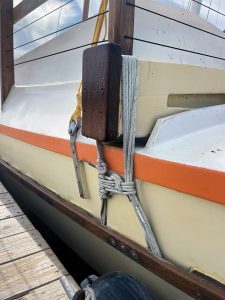
On this Wharram cat, the akas are securely lashed into “deck alleys.”
Designers have used telescoping akas, but production boats generally avoid the associated complexity and cost. The mechanically straightforward take-apart feature has successfully been used by many boats, like the 27 ‘ (8.2m) Stiletto Cat and others. Generally, the assembly of these boats takes some time and muscle, which relegates them to the transportable category. Stiletto Cat advertising suggests a four-hour setup time, but in reality, it is much longer. All the James Wharram–designed catamarans up to 63 ‘ (19.2m) are held together with rope lashings and can be dismantled for transport. The required time and effort are generally proportional to the length of the boat.
Note that the Gougeon 32 ‘ (9.7m) sailing catamaran is unique, at 8 ‘ wide, without folding capability but with a water ballast system to make up for the lack of form stability.
The large main hull of a typical smaller trimaran offers a larger interior space than a comparably sized catama ran, a deep footwell in the cockpit for comfortable seating, and a folding system for trailering with the amas connected to a well-supported main hull. In addition, the mast is stepped on the main hull, with the headstay attached to the bow, not to the akas.
Trailerable trimarans come in all sizes to about 32 ‘ long, with transportable designs somewhat longer. The latter types tend to have larger interior spaces and less complex connectives. To a certain extent, manufacturers were willing to add cost to the folding system to reduce setup time. Folding capability on or off the water also adds to the design challenges.
Take-Apart Aka Systems
This is the least expensive method and easiest to achieve for the home builder or the manufacturer. The akas may be built-up wood box beams or tubular metal. Each beam is secured to the hulls by through-bolts, bolted straps, plug-in sockets, or lashings. Tubular aluminum beams are the lightest but most expensive. Regardless of attachment method, the hulls must be supported in their respective positions for the akas to be installed. In small vessels, this can be an abbreviated procedure, but larger vessels will require a special trailer to hold the disconnected amas while on the road.
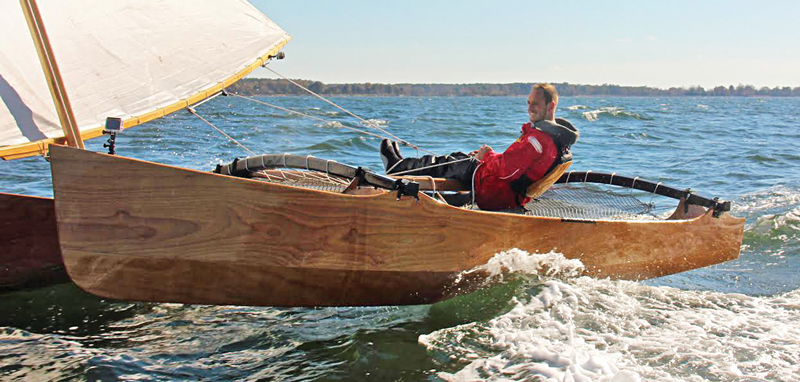
The Chesapeake Light Craft 15′ single outrigger canoe akas lash into saddles on both hulls.
Telescoping Aka Systems
The telescoping option is limited to boats where the total stack-up width and length dimensions of the hulls and fully retracted akas do not exceed the legal road limits. The WindRider 17 is a good example. The boat is supported on “high bars” on the trailer, leaving the amas free to be moved in or out. The simplicity of the akas and trailer-support system reduces cost and launching time.
In larger vessels, this system has been applied to reduce width for storage in marina slips. For these boats, the sliding system is large and complex, usually requiring some sort of power to make the telescope slide. Because the sliding mechanism requires a small clearance between the sliding members, the akas will move slightly during sailing, which is difficult to avoid.

The 1970s-vintage Telstar 26 features a simple hinge-down system with a bolted con- nection on deck and a bolted strut below.
Simple Horizontal Hinge Systems
Early trailerable trimaran designs often incorporated a simple hinged beam-reduction system to fold both sides down. Boats to about 25 ‘ (7.6m) with a 16 ‘ (4.9m) beam could be made to fold to 8 ‘ . At the ama end, lifting the hull, sometimes with attached wing deck, could require substantial muscle or a mechanical lift. Even for smaller boats this task may be beyond one person’s capability. Normally, bolts and plates between the members secure the hull for sailing. On the Searunner 25 and Constant Camber 26 (7.9m), double-hinged tubes are bolted to tangs on the main hull.

The Searunner 25 trimaran has a hinge mechanism on its metal-tube A-frame akas that secures with bolts at both ends.
Commonly, simple hinge systems require that the main hull be positioned rather high on the trailer so the amas clear the trailer wheels beneath. A disadvantage is that the trailer must be submerged more deeply than usual for the boat to float off. Compared to the Telstar system, the Searunner 25 offered some improvement by positioning the hinge point at the top of the cabinside, raising the folded ama slightly.
Complex Aka Hinge Systems
A complex system for folding multihulls, much like a garage door lift linkage, was developed and patented by Ian Farrier for his trailerable trimaran designs. It allows one person to fold or unfold the boat while it’s afloat. Before launching, the mast is stepped and secured with lower stays. Note that folded storage in the water for long periods is not practical because the immersed ama’s topsides will gather marine fouling. In addition, the arrangement of the support linkage arms has a very shallow angle with the aka, causing them to be highly stressed, which adds significant weight and cost.

Unfolding it requires help from friends.
A complex folding system I developed has only four attachment bolts and a wide-angle strut brace. It is very light but requires folding prior to launching. It relies on a simple roller dolly on a beam attached to the trailer to support the ama during folding and unfolding.
Swing-Wing Systems
In-water storage of folding trimarans is generally limited to swing-wing designs, where the hulls all float on their respective waterlines, either folded or unfolded. Many variations have been used in production boats, and among the most successful is the Quorning-designed Dragonfly. It has hinged arms supported by a “waterstay”— a diagonal cable under the arm to counteract cantilever aka loads. The outer end of the arm, on the ama deck, pivots on a single pin. The waterstay becomes slack when the boat is folded, leaving only the hinge to support the ama in the folded configuration. I’ve seen one folded boat that was damaged while moored at the dock in strong harbor waves when the ama climbed onto the dock. Swing-wing designs stored in the water must provide strong vertical support for the ama in the folded condition
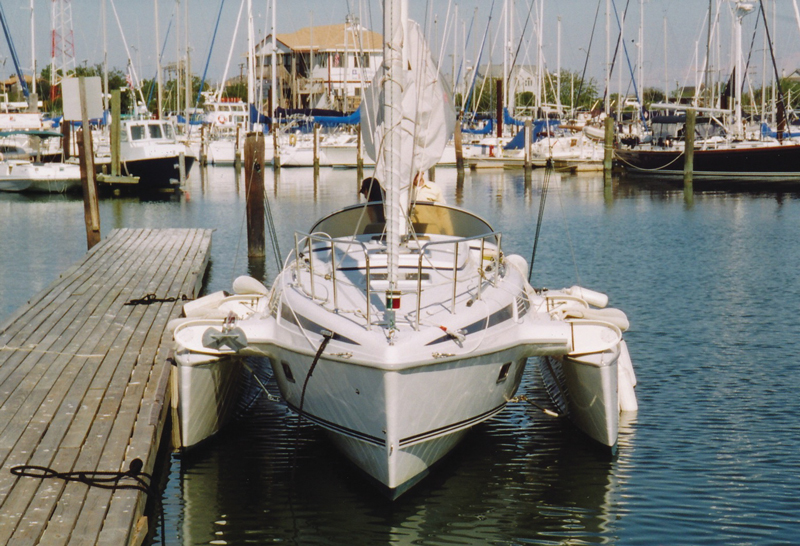
A swing-wing aka system on the Borg Quorning–designed Dragonfly 32 is further supported by a waterstay when rigged for sailing. The akas can be adjusted in and out while in the water and for storage at the dock.
The main challenge of the swing-wing system is to get all the pivot axes parallel because they must rotate about 90° without binding. If there is any depth to the structure, this accuracy is critical, as the pins or pivot axles could be quite long, so even a small inaccuracy will make the system difficult to assemble, let alone pivot smoothly.
Folding Multihulls with Flat Swing-Wing Akas
The most basic swing-wing system is the flat aka configuration developed by Jim Brown. He avoided the need for perfect parallel alignment of all hinge axes because the beams are not very thick, and the pivot-pin holes can have additional clearance. For the swing system to operate without binding, spacing of the pivot points must be identical on all the swing arms. The system’s downside is strength, because the aka must support all the heeling loads in a relatively narrow beam. For some boats, a waterstay may need to be added to increase cantilever strength and reduce deflections when sailing.
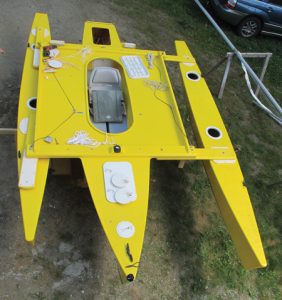
The Seaclipper 16 flat swing- wing akas are made from common dimensional lumber and pivot using steel bolts.
A logical improvement in strength for swing arms is to add a truss, with triangulated strength that will easily bear all the heeling loads from the ama. Here again, it is essential that pivot axes be in perfect alignment to avoid binding. To my eye, open trusses in sleek yachts are never beautiful, but they offer higher strength for lower weight.
Complex Swing-Wing Systems
If the akas are not flat along their full length, it is more difficult to achieve a smoothly pivoting system. My latest boat, Syzygy (pronounced, sis-a-gee), is a case in point. Flat akas offer little variation in styling—flat is flat. To add underwing clearance and more attractive aesthetics, many designers favor the arched aka. This configuration allows the aka to approach the ama hull from above and connect through the deck for more usable immersion of the ama buoyancy, and to keep the aka above the wavetops.
This system has arched akas with an upward angle (dihedral) as they extend from the main hull and descend with a smooth curve onto the ama deck. The pivot axis must also be inclined, normal to the surface, to allow it to pivot. To make life simple, the vertical centerline of the ama is inclined inboard at the top by the same amount, which aligns all the pivot axes with the ama vertical centerline. If the beam is level fore-and-aft, when the ama is folded inboard, it is positioned rather low, due to the arch. To compensate, the akas must be given a negative angle of attack to make the folded ama arrive in the same position as a simple flat aka system. It’s a good challenge for any boatbuilder to get it right and a good use of a digital level. The angles in Syzygy were 8° dihedral, and a nega tive 5° angle of attack. The aka pivot surfaces must be perfectly parallel on both ends—at the inboard aka pivots and the ama deck pivot tables.
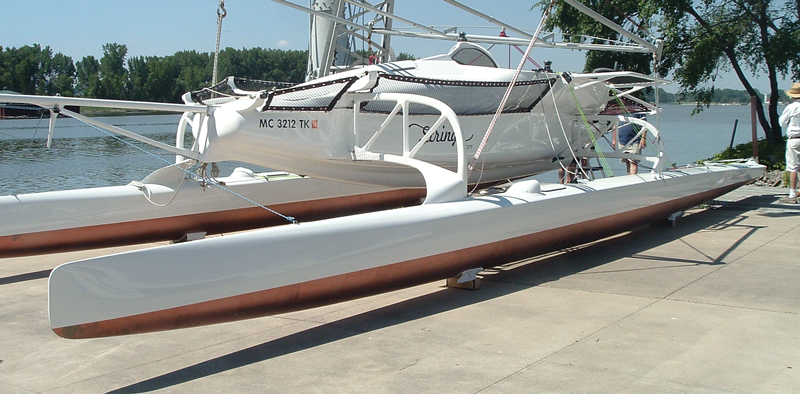
Jan Gougeon designed and built strings, a 40′ swing-wing catamaran with carbon- tubular-truss swing akas built over foam mandrels.
A late iteration of the Telstar 26 became the Telstar 28 with a vertical-axis swing-wing system. This production boat is no longer manufactured but was unique for its faired wing and attempt to hide the folding system from view. It also featured an electric linear drive to fold/unfold the heavy akas.
For transporting folding multihulls on the highway, road trailers must have some specific attributes to properly support the hulls. Most models use transverse cradle supports under the hull at major interior bulkhead positions. It is important to install bow guides on the trailer to get the hull to settle in exactly the right place when retrieved from the water. Rollers beneath the hull are not recommended, as they tend to distort it and potentially cause damage. The amas require enough support so the folding mechanism is not carrying the load when being towed.
For swing-wing boats, there is a significant change in the center of gravity between folded to unfolded configurations. Normally, the amas swing back when folded and swing forward for the sailing position. If the trailer has the proper tongue weight for towing on the hitch with the boat folded, the weight will increase when unfolded. For trailers with telescoping tongues, tongue design must accomodate that weight; otherwise, the extended tongue may bend severely during launching or retrieval.
Homebuilt wooden trailers are popular for these specialized boats, and some designers provide plans for them. Without much metal in them, they will probably float, which sometimes leads to difficulty at launching. Adding some steel channel to the bunks can solve that. However, floating is not an undesirable feature if a trailer floats level but is submerged enough to maneuver the hull into the bunks, and the hull settles into the right place automatically. Floating trailers also never run off the end of the ramp.
Conclusions
There’s truth in the humorous claim that “the new family yacht has to look good behind your SUV.” But while many of the latest small boats are daysailers, folding multihulls have expanded the trailerable and transportable boat size to include those with weekend cruising capability, up to about 32 ‘ . As we’ve seen, those essential folding or retraction mechanisms are not simple and must be carefully designed and engineered, even by the home builder. But for owners of these boats, seasonal storage and slip availability are no longer problems. And the overall reduction in total cost can bring owning a boat within reach for many more people. What’s not to like about that?
About the Author: John Marples has designed, built, and rigged many sail- ing vessels. His portfolio includes doz- ens of wood-epoxy composite sailing and power multihulls to 110′ (33.5m). He operates Marples Marine , a multihull design and engineering firm in Penobscot, Maine
Dieter Loibner | Professional BoatBuilder Magazine
Nomenclature
Multihull designers have developed some useful, specific names for components, mostly derived from the Pacific Islander language.
Aka (ah-kah) refers to the crossbeam structure of any multihull. Designers used to call them “cross-beams,” but writing that on hand-drawn plans took up too much space and time, so this shorter Polynesian name became the standard.
Ama (ah-mah) is the Polynesian name for the outer hull of a trimaran or proa. They were formerly named “floats” or “outer hulls” (never pontoons), but again, ama is shorter.
Vaka (vah-kah) is the Polynesian name for the main (largest) hull of a trimaran or proa. Since it can be confused with the other names and is not very descriptive, most designers have opted for the term main hull.
Waterstay is a diagonal stay, metal or synthetic rope, below the aka, between the main hull near the waterline and aka near its outboard end. This stay counteracts the upward load from ama buoyancy when the ama is immersed.
—John Marples
The Crossbeam (Aka) Structure
T he essential function of any crossbeam (aka) system on a multihull is to structurally connect the hulls in a way that resists all the forces generated when sailing. Heeling forces from lift on the sails must be transferred to the leeward hull by the aka structure. The forces on the akas are complex, composed of cantilever bending due to heeling loads, twisting of the structural platform, and horizontal bending caused by drag from the ama’s forward motion through the water. The heeling force, resisted by the buoyancy of the ama, pushes up, causing cantilever bending loads in the akas similar to the forces on an airplane wing. Torsion is created when the sails’ lift pushes the leeward ama bow down, while the shrouds supporting the mast pull the weather-side ama stern up. Drag from the leeward ama tries to bend the akas toward the stern, and forces from the windward shroud tend to pull the aka forward as well as up. These forces all act together at the attachment points on the hulls. In most cases, torsion is resisted by the tubular hull and cabin structure itself. Heeling is countered by the cantilever strength of the aka beams and is sometimes strengthened by diagonal waterstay cables beneath. Drag forces can be resolved by the fore-and-aft strength of the akas or by adding diagonal cables between the akas. Each folding system must accommodate these loads through all the pivoting components in the structure.
Of key interest in aka design are the loads imposed on the ama hulls by the seaway when sailing to windward. These hulls are subject to significant loads on the outboard sides. The windward ama is pummeled by wavetops, and the leeward ama is pushed sideways due to leeway. Since the aka system is characteristically attached through the ama deck, these forces are trying to rotate the ama keel inboard, toward the main hull, in either case. The same is true for catamarans, concerning the aka loads where they emerge at the hull inboard sides. These loads can be calculated to estimate the strength required for any configuration and should be part of the design’s stress analysis. If centerboards or daggerboards are located in the amas, those rotating forces are significantly increased.
Of further interest in swing-wing designs is the clearance between pins and brackets in vertical pivot mechanisms. When sailing, the forces at the hinge pins can change from positive to negative repetitively, creating noise and wear. The wear will eventually elongate the holes, reduce pin diameter, and become a maintenance problem. Designs like the flat wing can be tightened to eliminate movement, which will eliminate wear. Amas with waterstays tend to put the akas in compression and stop the vertical deflection that would be normally carried through the hinge pins. In that case, the pins would be loaded in only one direction and not be subject to cyclic ± loads. —J.M.
Read more Construction , Design articles

- Van der Werff’s Curved Wood
A Dutch yard adopts composite panel molding technology to build boats from preshaped wooden hull sections.

- Departures: Carl Chamberlin
Passionate, competent, considerate, modest, and thoughtful is how designer and boatbuilder Carl Chamberlin is remembered by those who knew him. He died last November at age of 75 in Port… Read more »

- SNAME Powerboat Symposium Is Back
The Society of Naval Architects and Marine Engineers (SNAME) Technical and Research Program, in cooperation with the Hampton Roads, Virginia Section of SNAME, will host the Sixth Annual Powerboat Symposium… Read more »

Recent Posts
- Find out how 3D printing can help your boatbuilding with MASSIVIT
- SAFE Boats Regains Small-Business Status with Employee Ownership
- Companies (85)
- Construction (106)
- Design (161)
- Drawing Board (10)
- Education (25)
- Environment (16)
- Events (21)
- Materials (50)
- Obituary (18)
- People/Profiles (49)
- Products (16)
- Propulsion Systems (32)
- Racing (16)
- Repair (37)
- Rovings (317)
- Short Cuts (3)
- Sponsored Partner News (14)
- Systems (80)
- Task Sheet (1)
- Uncategorized (26)
- Wood to Glass (7)
ProBoat.com Archives

IMAGES
VIDEO
COMMENTS
24 Foot Sailing Trimaran: Indonesian style, built out of recycled stuff.Here we are busting out through the surf in 30mph winds at Stinson Beach California on the maiden voyage. ... DIY Electric Kayak by BradenSunwold in Boats. 139 14K "Sun-Brella Greenhouse Effect Cooker": Working Solar Cooker for the Vulnerable, Refugees, Eco-Enthusiasts and ...
The DESIGNER'S book TRIMARAN and CATAMARAN CONSTRUCTION is part of the plans (over 21') and covers all phases of construction. Plans are leased to build ONE boat, NO time limit. Tri-Star designs are proven designs, sailing the seven seas since 1964. Free consultation is provided to the original non-professional builder till he or she is sailing ...
After all the cat's my first trimaran. I built the boat in 136 hours.After many requests a plan is made for the boat.Construction time lapse: https://www.you...
Learn how Mick Milne built his own 18-foot DIY trimaran with plywood, fiberglass and epoxy. He sails it in calm coastal waters and shares his photos, videos and tips on the design and performance of this small tri.
Small Trimarans Report. Back in 2010, sailor/naval architect Mike Waters published a 22-page report covering 20 small trimarans. It includes charts, graphs, photos, and critical objective reporting on many of them. Read more…. Review of nine Small Trimarans. Mike Waters' review of nine small folding trimarans 14-20 feet including six ...
Handmade 16 feet Trimaran Designed and Built by Mike Perras. Built in less than 4 Months on weekends and weeknights.Made with Mahogany Marine 1/4" Plywood, E...
This is our video series showing the full build of our Tryst 10 trimaran sailboat. The Tryst 10 main hull is a Duo 10, so the first 12 or so episodes will be...
Order the Latest Design Portfolio today to see over 85 multihull plans in stock. Besides illustrating my stock designs, for which I sell study plans and full construction plans, it also contains my design philosophy of multihulls; an article on the rapid Cylinder Mold (pdf) or Cylinder-molding (in html) multihull construction; examples of ...
Catamaran Stock Plans. Ed Horstman designed TRIMARAN and CATAMARAN plans are drawn for the first time builder. Plans are concise and clearly drawn so the builder can easily follow each building step. Designs are continuously updated with your input and new ideas. Plans include full size patterns to 63'.
Learn how to build your own 8-metre or 9-metre trimaran with the M80 kit designed by Wayne Barrett, a famed multihull designer and builder. The kit is simple, economic and adaptable to different materials and sizes. The web page also features other DIY tri projects and tips from the author.
The Back Bay can be configured with a large, open tankwell set aft of the cockpit, or built with a watertight, aft hatch cover for internal storage in a conventional kayak style. Specifications: Beam overall - 10′. Weight (est.) - 90 lbs. Sail Area - 56 sq. ft. Displacement - 350 lbs. Draft (board down) - 28″.
Initially, the choice for my new to build boat fell on the high-tech F-36 trimaran, a design by the famous New Zealander Ian Farrier ( † RIP Dec.8, 2017). In those days the F-39 did not exist yet. Although the F-36 missed my preferred folding option, the design nevertheless meets most of my wishes. According to Farrier, there was simply not ...
Learn how to build your own catamaran or trimaran with Hartley Boats NZ, a leading provider of boat plans and materials. Choose from a range of sizes, designs, and materials to suit your budget and preferences.
A folding trimaran for DIY boat builders by Michael Leneman, Multi Marine Above: A completed L-37 multihull at the dock. Multi-Marine's new 23' folding trimaran kit features manufactured hull pans. The builder attaches plywood topsides to the pans. What is the simplest way for a home builder to build a good, light hull for a
DIY tri capturing imaginations. 02/04/2020. Wayne Barrett has been building boats for 50 years, many of them world renowned. His latest venture is a DIY trimaran kit that embodies his half-century of expertise and celebrates "the joy of building and sailing your own creation". Famed in multihull circles and the creator of high profile ...
The Threefold 6 is designed to be a safe and lively boat to sail singlehanded or with a crew, ideal for comfortable gunkhole cruising in relatively protected waters. Follow these links to print a material list or a drawing list for this design. with the aluminium folding system. Oleg's boat with new colour scheme.
Place the widest one with most volume in the center. Obviously, if you kept the hull in this level position, your trimaran would be dragging 3 hulls through the water with far more drag than for a catamaran. So you need to lower the central hull, so that it will support your 900 lbs .. requiring 14 cu.ft volume under the waterline.
The Discovery 20 trimaran is a fast, fun daysailer with the potential to be a camper/cruiser for the adventurous. The D 20 design has been updated as an exciting and powerful new daysailer. It is available as a kit or a complete boat. This design is intended for enjoyable day sailing, although there is space below deck for camping gear.
Simple Exercise On A DIY Foiler Trimaran. Discussion in 'Multihulls' started by yigitozturk, Nov 12, 2017. Joined: Nov 2017 Posts: 5 ... Meanwhile got overdosed with trimarans (They are everywhere when you are searching for s&g) and one day saw the Broomstick of Mr. Doug Halsey. It was an eye-opening moment for me.
Here are 6 of the best trailerable trimaran: The Dragonfly series. F-22. Corsair Series. Astus. Weta 14.5. Windrider 17. Choosing the best trailerable trimaran (a multi-hull with three "hulls") will depend on crucial factors like speed, durability, design, and ease of transportation.
His latest venture is a DIY trimaran kit that embodies his half-century of expertise and celebrates "the joy of building and sailing your own creation". Famed in multihull circles and the creator of high profile vessels such as 'Trilogy' and 'Indian Chief' designed by Tony Grainger, and 'Traveller', the 50-foot tri designed by ...
Twice heavy than the Triraid (210 / 110), but the Astus 16,5 can be sailed quietly, reversely the Triraid cannot be hard sail because the limited volume of its ama. The Astus 16,5 is more relevant in your cat. 3 although the central hull is not specially wider planning, she is more like a baby oceanic trimaran racer.
Hobie Cats and other beach cats are familiar sights around lakes, beaches, and harbors. They are usually built to 8' (2.4m) beam and do not need folding systems. The 19' (5.8m) Tornado class catamaran at 10' wide uses a side tilt-up trailer to reduce beam. Larger catamarans needing folding systems have greater challenges than trimarans of the same length, for a few reasons: The hulls are ...